
――――♦――――
|
FOREWORD
This booklet is intended as a small tribute to the men and women of
Tring who served in the Great War. I am aware that its content
is patchy, nevertheless I hope it gives a flavour of the spirit and
thinking of that dreadful time. It is impossible to list every
name, for during the four years of conflict more than 500 are
recorded as playing some part in the armed forces, of whom more than
110 were killed in the line of duty or died later from the effects
of wounds or disease. The 107 names inscribed on Tring War
Memorial bear testimony to the War’s impact on the town, although
Tring’s losses are a fair average for the country overall.
To provide background, the first chapter comprises notes on the
progress of the War during its five years; this is followed by
extracts from letters sent to Tring from the various theatres and
the various services. Undoubtedly all serving men and women
wrote to their loved ones and friends, but after almost a century
few letters survive, while those still treasured among family
possessions are difficult to trace. In most instances it
cannot be said that the letters are particularly interesting; the
young men who wrote them, some only teenagers, were probably unused
to letter-writing and at any rate the censor did not allow soldiers
at the front to say where they were or what they were doing. A
sample of letters sent to Tring by the commanding officers of those
who died are also included, as is some relevant correspondence
written to or by civilians living in the town; some are mere
fragments while others cannot be traced to a particular individual.
The booklet could not have been compiled without the generosity of
Jill Fowler, Ann Reed, and Mike Bass who shared their researches
with me; and also the late John Bowman who amassed a great deal of
information on the Great War, especially regarding the men from
Tring who fell. I also acknowledge with thanks the help of
John Fountain, Susan Gascoine, the late Heather Pratt, the late Alan
Rance, the late Don Riddell, Frances Warr, the staff of Aylesbury
Local Studies Centre, Tring Local History Society who lent some
items from its collection, and Ian Petticrew who proof-read the
text.
W.M.A.
Tring, November 2014.
――――♦―――― |

Issued by Tring Urban District Council to all
men of the town
who served in the armed forces.
――――♦――――
|
NOTES
ON
THE
PROGRESS
OF
THE
WAR:
1914-1919
1914: the political events leading up to the
assassination of the Archduke Franz Ferdinand in Sarajevo on 28th
June are long and complex. Suffice it to say that although this
event
triggered the Great War, it did not result in Britain’s immediate
involvement. This came on 4th August when, following Germany’s
attack on France through Belgium, Britain, having chosen to honour
its obligation to defend Belgian neutrality
under the terms of the 1839 Treaty of London [1] —
declared war on Germany. By this time Germany was already at war with Russia and had allied itself
with Turkey.
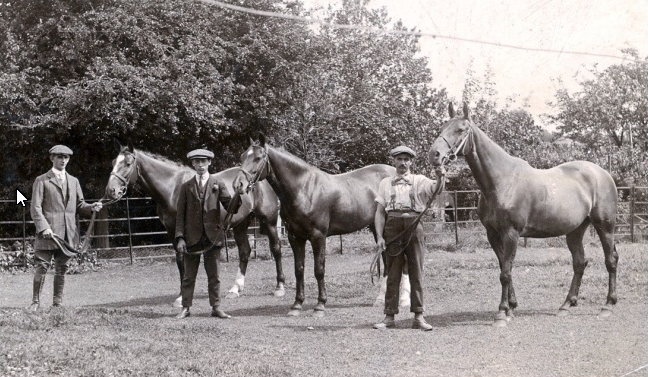 |
|
Hunters owned by William
Mead of New Mill, requisitioned
for War Service on 4th August 1914. |
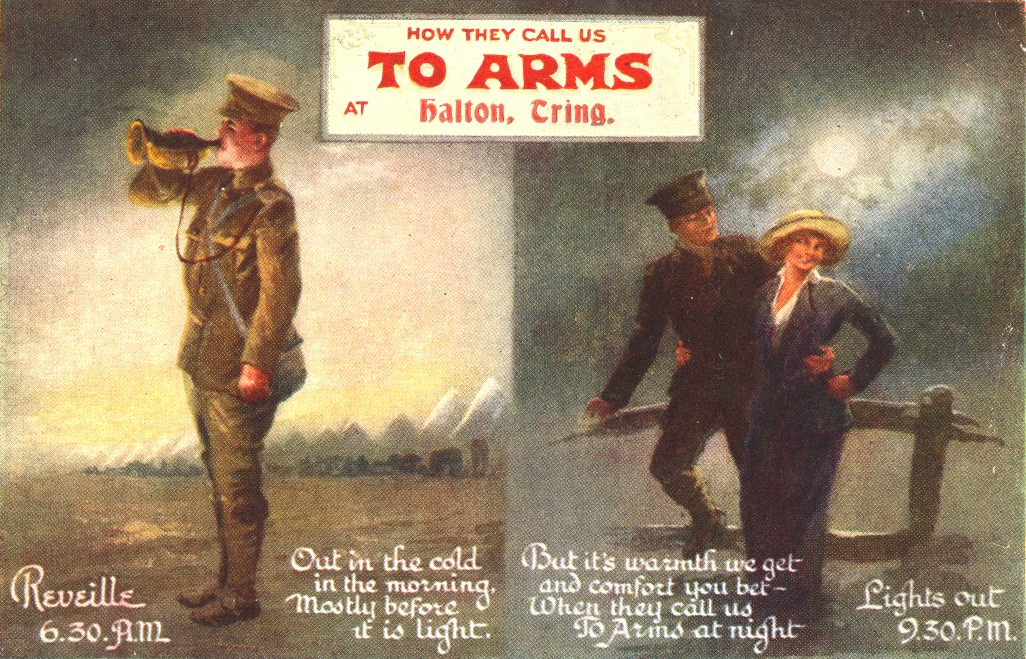 |
|
Postcard sent from Halton Camp. |
 |
|
Postcard sent from Halton Camp, where the mud was seen
as a joke. |
Following the commencement of hostilities, reservists were soon
reporting to their naval and army establishments. Men of the
Territorial Army (primarily a home defence force) mustered at their
local drill halls and volunteers were requested to sign for service
where required. One of the first direct impacts on the town came
very shortly afterwards, on the day of the annual Agricultural Show
held in Tring Park, when horses of every size and breed were
numbered and catalogued ready for war. Two weeks after the
Declaration, Lord Rothschild made known to his employees on the
Tring Park estate that it was his wish that every unmarried man of a
suitable age should offer his services. About 20 men from the
gardens, timber yard, the Home Farm and other departments journeyed
to Aylesbury to join Lord Kitchener’s Army.
Field Marshal Lord Kitchener was a distinguished colonial
administrator and Army officer who won fame for his imperial
campaigns in the Sudan and South Africa. Following the outbreak of
war Herbert Asquith, the Prime Minister, appointed Kitchener
Secretary of State for War, and to him fell the task of organising
what became the largest volunteer army that Britain — and indeed the
World — had seen. Following his appointment, Kitchener set out to
supplement Britain’s small regular army by calling for 100,000
volunteers to strengthen the British Expeditionary Force, then
engaged in supporting the French and Belgians against the Kaiser’s
Army. [2] Having achieved this target in the
first few days of the proclamations, preparations were then made to
recruit a further 100,000 men. Local newspapers displayed
advertisements urging men aged between 19 and 38 to enlist quoting
Field Marshal French, then Commander-in-Chief – “It is an Honour to
belong to such an Army”.
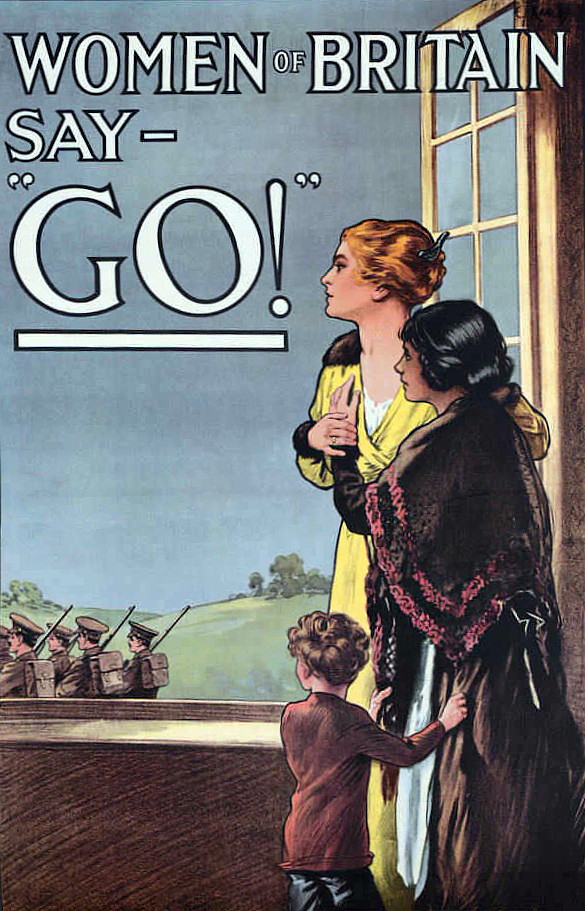
On the 8th August 1914, The Defence of the Realm Act was passed
giving the Government wide-ranging powers during the period of
hostilities; for example, to requisition land and buildings needed
for the war effort, and to make regulations creating criminal
offences, such as discussing naval and military matters. And in an
effort to curtail excessive drinking, alcoholic beverages were
watered down and pub opening times were restricted to noon - 3pm,
and 6:30pm - 9:30pm.
In September, it was rumoured locally that a new army division was
to be formed at Halton Park, which had been offered to the Crown as
a further Rothschild contribution to the war effort. A tented camp
was hurriedly erected on what is now the airfield and men began
arriving from Northumberland, Durham and Yorkshire to form the 21st
Division. Due to a very wet autumn the camp soon became waterlogged
and the soldiers had to be moved out and billeted in any available
accommodation; 3,000 were housed in Tring, mostly with local
households. The billeting rates paid for soldiers were generous for
the time and no doubt supplemented the income of townspeople that
had been lost when so many of the male population had volunteered
for service . . . .
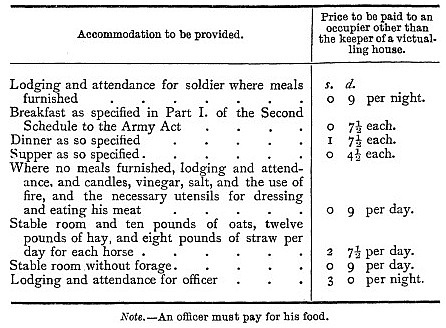
From: The Bucks Herald, 19th December 1914:
The continued presence of military in
the district is proving a boon to Tring, for it means the
circulation of money and the provision of employment. Tradesmen were
looking forward to a very slack time this winter, but the fixing of
the Headquarters of the 21st Division in the town and the billeting
of something like 3,000 soldiers has falsified this apprehension . .
. .
The school in Tring High Street was commandeered and the pupils
moved to various locations in the Town. Boys went to the
Church House and Market House, girls to the Lecture Hall in the High
Street Free Church and to the Western Hall (now the site of Stanley
Gardens), while infants were sent to the Sunday School room in the
Akeman Street Baptist Chapel. Further along the street the YMCA
building in Tabernacle Yard was opened as a writing and reading room
for soldiers, for whom bathing facilities were installed in the
Museum outbuildings. The Victoria Hall and Gravelly School (at
the top of Henry Street) were converted to medical and hospital
accommodation.
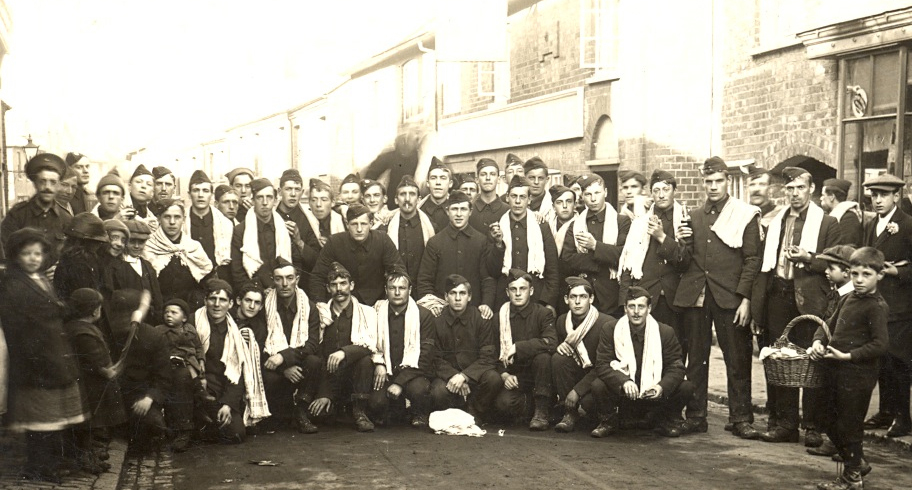
A bath parade in Akeman Street.
1915: the year began with the population being alerted
to a new form of attack — by aerial bombardment. This from The Bucks
Herald, 30th January:
PRECAUTION AGAINST
ZEPPELIN RAIDS. —
The police, acting on instructions from the County Constabulary
authorities, on Tuesday issued orders to the residents to lower all
lights at night and to dispose as far as possible with outside
illuminations. The street lamps were not lit, and the streets
presented quite a gloomy appearance. These precautions are being
taken in view of a possible raid by Zeppelins over the district, but
it is explained that such a raid is very unlikely to take place so
far inland. The special constables are out at night watching for any
signs of the approach of aircraft.
From: LIEUT. COLONEL LORD
CROFTON, 13th Northumberland Fusiliers,
to Mrs. Anderson of Westbury, Tring, after some of the Division had
left for France:
France, 9th January 1915.
Dear Mrs. Anderson,
I am writing on behalf of the NCOs and men of this Battalion to
thank you and the Tring friends of the Battalion for the cigarettes
and chocolates which were so very much appreciated by all, not only
for themselves, but for the kind thought which prompted the Tring
people to send them, and to think that the Battalion is not
forgotten, as the Tring people will certainly never be forgotten by
the Battalion for all their kindness to everybody. I am afraid
you will have thought that no acknowledgement was coming, but to
tell you the truth the things only arrived the day before yesterday.
With best wishes from the Battalion to everybody at Tring, and again
many thanks,
Yours truly,
CROFTON,
Lieut. Colonel commanding the 13th
Northd. Fusiliers.
On Saturday afternoon
Field Marshall Lord Kitchener, Secretary
of State for War, paid a brief visit to Tring for the purpose of
inspecting various contingents of the 21st Division who are training
in the neighbourhood. The greatest interest was manifested in
the War Secretary's visit . . . . Lord Kitchener inspected as many
Battalions as the time at his disposal permitted, and afterwards the
troops who has been inspected marched past the saluting point, where
the War Secretary stood with the Staff Officers. On leaving
the parade ground he was cheered loudly.
Bucks Herald, 27th March 1915. |
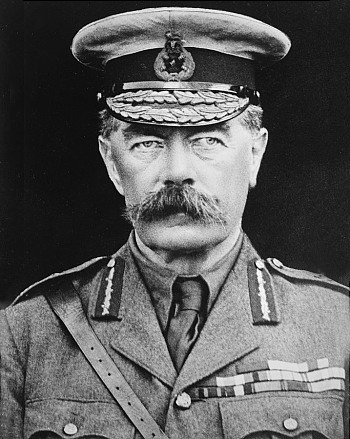 |
In Tring, various groups of ladies began knitting ‘comforts’ for the
troops, for it was quickly realised that scarves, gloves and
balaclava helmets were welcomed by those in the trenches.
From: MRS. C. M. WILLIAMS
to The Editor, The Bucks Herald:
Pendley Manor,
Tring, Herts.
3rd June 1915
Sir,
I have received a very urgent appeal from the Herts. Red Cross for
thin flannel or cotton nightshirts. They are in great need of
these articles at the present moment for hospitals in the county.
It is thought inadvisable to hold work parties in the summer, but
many may be willing to work at home for this object. I shall
be glad if any who are able to help will come to Pendley Manor at 8
p.m. on Wed. next to discuss the question.
Yours faithfully
(Mrs.) C. M. Williams
By the summer, the 21st Division had all left Halton Camp and were
in action around Loos and La Bassee. The Camp then became the
training ground for the East Anglia Regiment. In that year a number
of local men served in the disastrous Gallipoli campaign, [3]
as well as being part of the combined force of French and British
troops that had occupied Salonika and moved into Thessaly and
Macedonia in support of the retreating Serbian Army. The
casualty lists grew depressing long; almost every family in Tring
had a relative who had been killed or was missing, wounded or taken
prisoner, or had a friend or neighbour who had suffered in this way.
By now the Front had settled into a line of trenches that was to
remain little changed until 1918. This system varied from an
elaborate mishmash of deeply excavated trenches in the Arras/Somme
area, to built-up defences in the flat coal-mining areas around Vimy/Lens/Bully
and the Ypres Salient, where the water table was a mere two to three
feet beneath the surface. Large numbers of sandbags were
needed for these defences — it is estimated that each division of
15,000 men would need over one million bags a month — together with
wattle hurdles, chestnut paling and withy fascines. Voluntary
women’s groups were organised from North London collecting points to
make sandbags, the purchase of hessian in the Home Counties being
undertaken locally, and by September, 10,000 sandbags a day were
being despatched to the Front. The collecting point in Tring
was Hazeley in Station Road, the home of Miss Helen Brown.
1916: saw the Military Service Act come into
operation, which allowed the workforce to be directed as required to
support the war effort. Local tribunals were established to
grant exemption for men with large families, men and women who held
essential jobs, and men running family businesses and farms.
For those for whom the tribunals’ pronouncements were unacceptable,
there was recourse to an area appeal board.
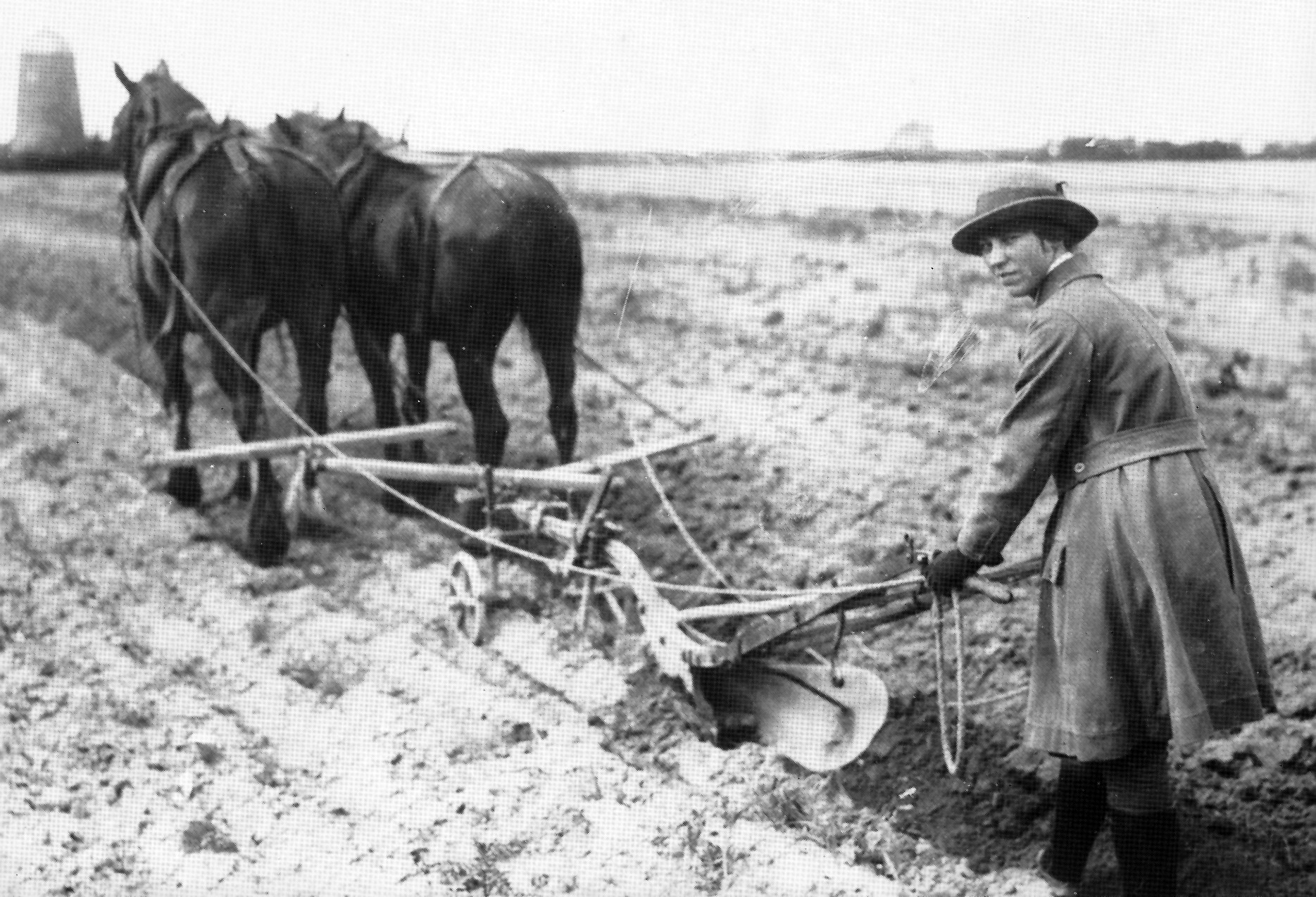
Myryl Smith of Tring ploughing a field
off Icknield Way.
Goldfield Mill is left background.
By now, the shortage of food caused by the German submarine campaign
was affecting the population. [4] Supplies
were not only limited, but prices were abnormally high.
Encouraged by the Government, steps were taken at local level to
increase the production of vegetables, with every available piece of
vacant land being placed under cultivation, including more areas
becoming allotment gardens. [5] The shortage
of labour on the land was circumvented by the formation of a women’s
volunteer force, ‘The Women’s Land Army’ (a recruiting rally held in
Tring in June 1918 attracted young women to a gathering outside
The Britannia public house, where some rousing addresses were
delivered by local worthies, followed a march through the town).
Women also played a vital part in Post Office work (post women were
seen in Tring for the first time) and women were also directed into
munitions factories. Felling of the Chiltern beech woods began
to provide pit props and duck boards for the trench systems in
France, and three forestry engineer units were put to work in the
area, one being Australian. The consumption of timber at the
Front was so great that a special port facility was built on the
River Seine at Rouen solely to address the need. The meadows
in the Vale of Aylesbury were in great demand for the provision of
fodder for horses, many thousands of which were used for
transportation and supply by the army, both at home and in France.
On 19th March, the Church Council discussed building a War Memorial
[Appendix] to commemorate the young men of the town who had given their lives.
It was suggested that the memorial should take the form of a
crucifix similar to the roadside shrines familiar to all soldiers
who had served on the Western Front. War savings groups were
formed under the auspices of the National Savings Committee, and
street marshals collected pennies for stamps which were affixed to
cards. When full (15s. 6d) they were exchanged for a
certificate worth a pound sterling in five years.
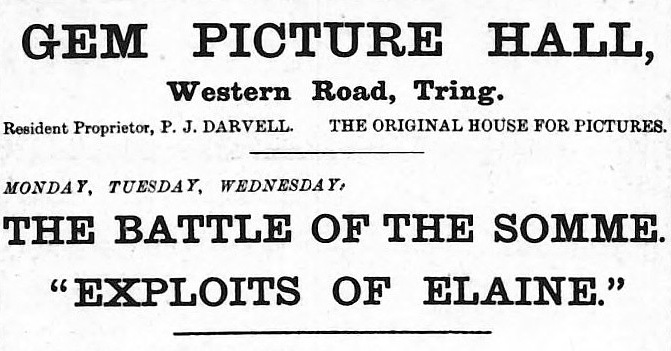
Bucks Herald advertisement, 1916.
The Royal Flying Corps moved into the north camp at Halton and a
flying field was established with an Australian Squadron. The
training organisation was concentrated in the new workshops being
built by German prisoners of war under the direction of the Royal
Engineers.
From the 31st May to 1st June, the Battle of Jutland was fought
between the Grand Fleet commanded by Sir John Jellicoe and the
German High Seas Fleet commanded by Vice-Admiral Reinhard Scheer.
It was the largest naval battle of the war and the only full-scale
clash of battleships, with both sides claiming victory.
Although the Royal Navy lost more ships and twice as many men as
their opponents, the High Seas Fleet was forced to retire, never
again to venture to sea in force. Germany now turned its
maritime war effort to unrestricted submarine warfare, with great
effect.
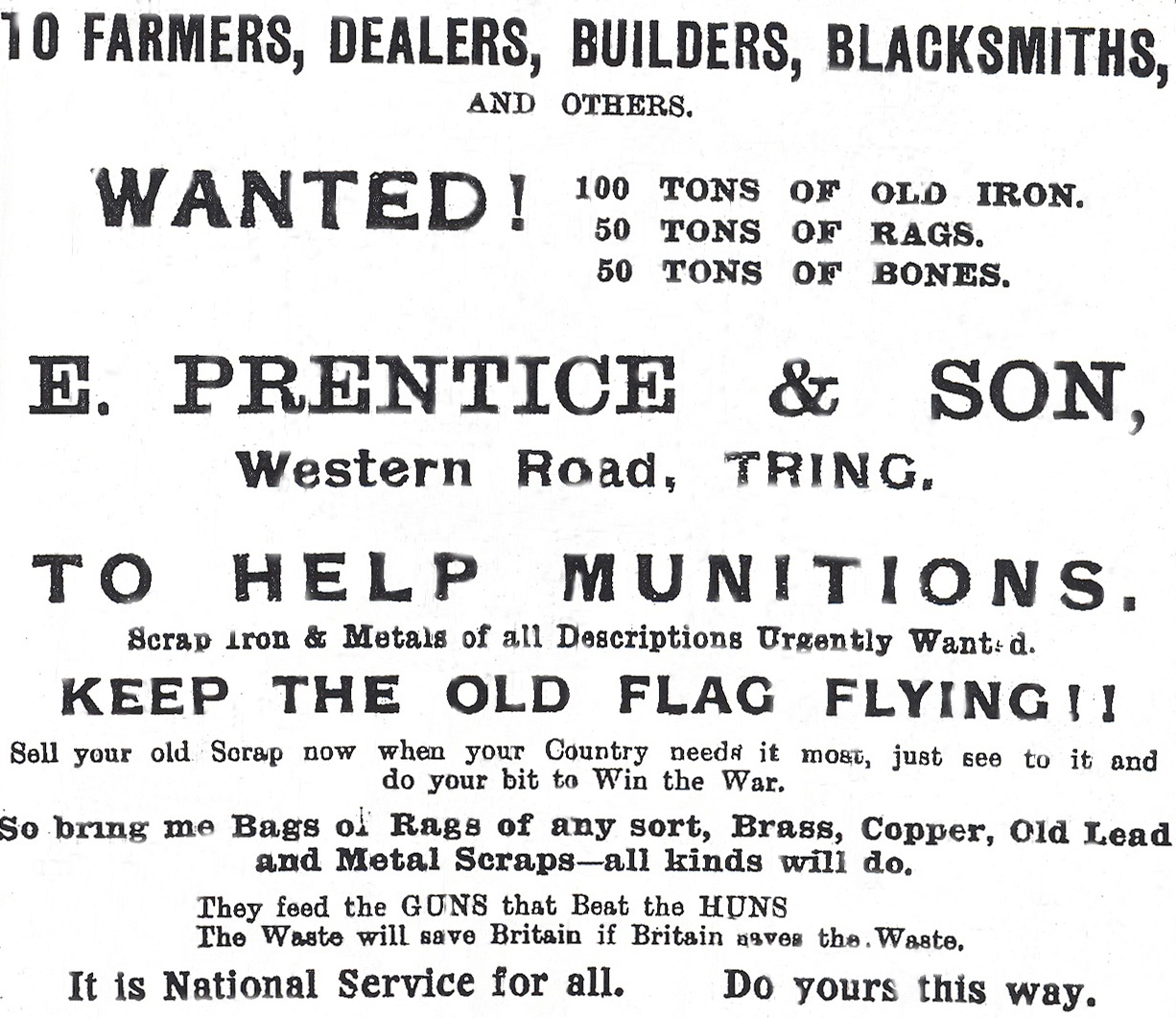
Bucks Herald advertisement, 1917.
On land, the Western Front extended some 400 miles from the Swiss
frontier to the Channel coast; stalemate had been reached.
Preparations were made for a major campaign on a 25-mile front in
the area north and south of Albert, its chief aim being to divert
German resources away from Verdun where the French Army was under
great pressure. The ensuing Somme Offensive (the ‘Big Push’)
raged from July to November; the outcome was inconclusive with both
sides suffering huge casualties. [6] During
this period yet more names were added to Tring’s Roll of Honour.
On 30th May, London was bombed for the first time, the Zeppelin raid
killing seven and injuring thirty-five — a portent of things to
come. On the 3rd September, a Zeppelin was reported over
Tring; this from The Bucks Herald:
|
“ZEP” SCARE. — Soon after
midnight on Saturday a warning to prepare for an air
raid came through. Specials and firemen were at
once called out, and at the military hospital
preparations were made for the reception of casualties.
How near the Zeppelins came to Tring is uncertain, but
the light from the one that was set on fire and which
fell at Cuffley was distinctly visible in the town
illuminating a wide area, and the noise made by the
engines was plainly heard. It was 4.40 on Sunday
morning before the danger was reported over, and the
tired specials and others were permitted to return to
their beds. |
1917: in April, a British offensive commenced in the
Arras area of the Western Front during which the German army was
pushed back resulting in the capture of the Vimy Ridge by the
Canadian Army Corps.
By May, the German submarine campaign was causing serious losses to
British merchant shipping and to our vital imported food supplies.
So critical was the position that the King issued a Royal
Proclamation exhorting the population to exercise the greatest
economy in the use of all kinds of grain, including that used to
feed animals. Householders were asked to reduce their
consumption of bread by at least a quarter and only to use flour for
making bread.
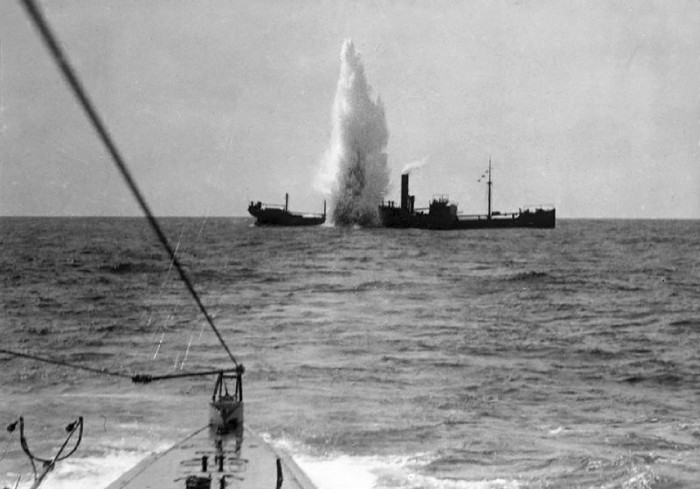
British freighter SS Maplewood being
sunk by German submarine U-35 on the
7th April 1917. In all the
U-35 sank 224 ships for a total of 539,741 gross register tons.
Women were already serving in various nursing services, such as the
Voluntary Aid Detachment (VAD) and Queen Alexandra’s Royal Army
Nursing Corps (commonly known as the QAs). To these units the
Navy and Army now added their own female services, the Women’s
Royal Naval Service (Wrens) and Women’s Army Auxiliary Corps (WAACs)
to take over such duties as driving vehicles, catering and clerical
work, in order to release men to fill the increasing gaps in the
fighting forces.
On the 6th April — following the sinking of American ships in what
Germany classed as ‘war-zone waters’ — the U.S.A. declared war on
Germany and on the 26th June, 14,000 U.S. infantry troops landed in
France to begin combat training.
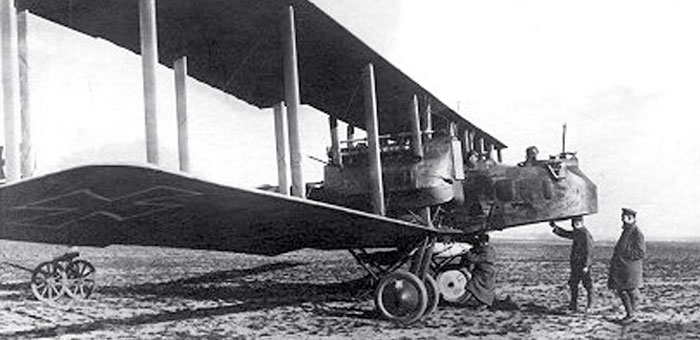
German Gotha heavy bomber.
The 25th May saw the first German aircraft (as opposed to Zeppelin)
raid. The target was London, but cloud cover caused the
‘Gotha’ bombers to divert to targets on the S.E. coast; this from
The Times:
Heavy casualties — 76 killed and 174
injured — many of them women and children, were caused by a German
air raid on a big scale on the South-east Coast on Friday evening.
Nearly all the casualties were in one town
[Folkestone], the name of which is not
given in the official report of the raid. The German official
report mentions Dover and Folkestone. On their return journey
across the Channel three of the German aeroplanes were brought down
by fighting squadrons of the Royal Navy Air Service from Dunkirk.
On the 13th June, a daylight attack on London killed 162 civilians,
the highest death toll from a single air raid on Britain during the
Great War.
1918: the Bolshevik Revolution resulted in Russia
ceasing hostilities with Germany in March, thus allowing thousands
of German and Austrian troops to be moved to the Western Front.
Later in the month the now strengthened German army under Ludendorff
launched a major offensive in the West. With American troops
still to join battle, the Germans advanced rapidly, crossing the
River Somme and pushing the French back towards the Marne, but the
German offensive gradually petered out and by July the tide had
begun to turn. A concerted Allied counter-offensive drove the
Germans back beyond their starting point. German military morale
began to crumble, exacerbated by the huge manpower and economic
might that the U.S.A. brought to the conflict.
On 1st April, the Royal Air Force was formed from an amalgamation of
the Royal Flying Corps (RFC) and the Royal Navy Air Service (RNAS).
As aircraft developed, the RFC had taken an increasingly offensive
stance in which enemy lines of communication were targeted; even
industrial complexes in the Ruhr and Saar areas came under aerial
attack. During the last five months of the War, British
aircraft dropped a total of 550 tons of bombs (including 390 tons
dropped by night) on German targets for the loss of 109 aircraft.
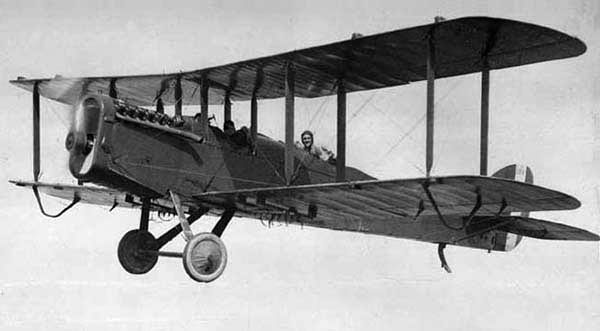
World War I. British bomber, the Airco
DH. 4.
By now the German nation was being worn down by lack of food
resulting from the British naval blockade, which together with the
appalling casualty lists was causing strikes and demonstrations
across the country, and there was growing fear of a Russian-style
revolution. With the country rapidly becoming ungovernable,
Germany sought an armistice, which was concluded on 11th November.
Vast crowds gathered in Trafalgar Square to celebrate the victory,
but when news of the Armistice reached Tring there was not the great
burst of jubilation that might have been expected. Over four
years of bereavement, hardship and privation had left behind a
mixture of emotions as well as uncertainty about the future, and
no-one was foolish enough to imagine that everything could revert to
how it had been before the conflict. A brief account of the
receipt of the news was reported in The Bucks Herald of 16th
November:
THE ARMISTICE
– Expectant knots of people were in the streets
[of
Tring] during Monday morning awaiting
news of the signing of the Armistice, but it was not until just
before eleven o’clock that the first definite news arrived in the
shape of a phone message from the YMCA Headquarters. As if by
magic, flags appeared from windows of adjacent residences, and
shortly after the incessant blowing of whistles at Aylesbury was
heard, which confirmed the receipt of the glad news. The
official Press Association telegram was posted outside the branch
office of The Bucks Herald and the streets were quickly
thronged with flag-bearing youngsters, while older people were
congratulating each other on the conclusion of the long period of
trial through which the country had been passing. There was
very little excitement in the town, the news being received with
grateful calmness, due no doubt to the grievous losses experienced
by so many families. Streamers of flags were hung across the
street, and by afternoon the town presented a festive appearance,
the bells ringing out a merry peal soon after noon, and again in the
evening, after a thanksgiving service in the Parish Church. A
service of thanksgiving also took place at the Akeman Street Church.
1919: although the Armistice marked the end of
fighting, six months of negotiations between Germany and the Allied
Powers were to follow before a peace treaty was concluded. The
Treaty of Versailles was signed on 28th June 1919, exactly five
years after the assassination of Archduke Franz Ferdinand, the event
that led to the catastrophe. The terms imposed on Germany
included substantial territorial concessions and the payment of
heavy reparations, and the Treaty was only ratified by the German
government with great reluctance. Whether the Treaty terms
were excessively harsh remains a subject of debate among historians,
but what is clear is that the resentment they caused in Germany led
to the eventual rise of the Nazi Party; as Field Marshall Foch put
it, “This [the Treaty] is not peace. It is an Armistice
for twenty years.”
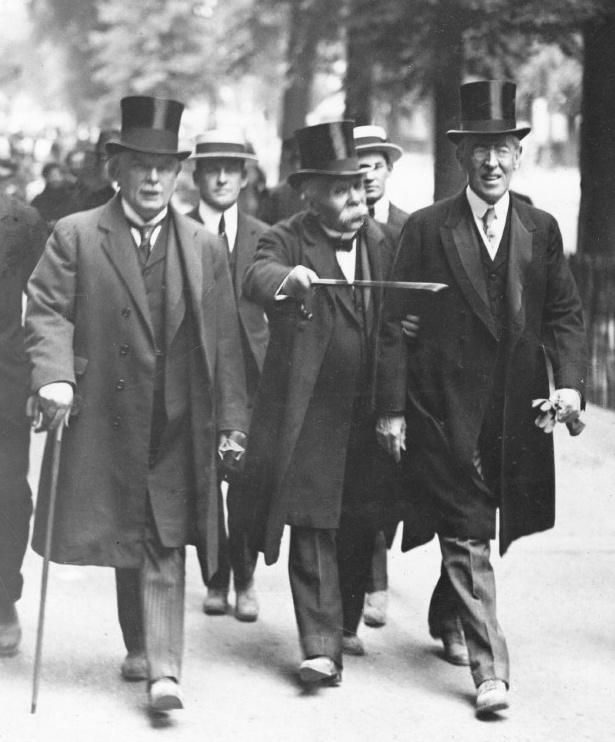
The “big three” - Prime Minister David
Lloyd George of the United Kingdom, Prime Minister Georges
Clemenceau of France, and President Woodrow Wilson of the United
States attend the Versailles Peace Conference, 1919.
At home, the joyous mood in the country following the end of
hostilities was short-lived. Many soon realised that post-war
Britain did not seem like a country that had just experienced a
great military triumph, for various political, economic and social
problems ensured that the our nation’s return to peacetime
conditions was not to be a quick and easy transition. Although
demobilisation was relatively unproblematic, the end of the war
witnessed many workers becoming involved in strikes, and by 1921
unemployment reached its highest point (11.3%) since records began.
Staple wartime industries such as coal, ship-building and steel
contracted, and working women were forced to relinquish their jobs
to returning soldiers. During the conflict, Britain incurred
debts equivalent to 136% of our gross national product — our major
creditor, the U.S.A., was soon to emerge as the world’s leading
economic and military power. [7]
|
Tramp of feet and lilt of song
Ringing all the road along.
All the music of their
going,
Ringing, swinging, glad
song-throwing,
Earth will echo still, when
foot
Lies numb and voice mute.
On, marching men, on
To the gates of death with
song.
Sow your gladness for earth’s
reaping,
So you may be glad, though
sleeping.
Strew your gladness on
earth’s bed,
So be merry, so be dead.
Captain
Charles
Sorley [8] |
――――♦――――
LETTERS
FROM
THE
WESTERN
FRONT
|
Kill if you must, but never
hate,
Man is but grass and hate is blight;
The sun will scorch you soon or late,
Die wholesome then, since you must fight.
Captain Robert Graves |
From: BOMBADIER PERCY SEABROOK,
35th Brigade Royal Field Artillery, one of four sons of Edwin
Seabrook, of Albert Street, serving in the Army or Navy:
8th December 1914
Dear Mother and Father,
Just a few more lines in answer to your letter. I am glad to
know you are still well. I am well at the time of writing,
only wet through to the skin. It makes the third wet shirt in
24 hours, but we take no notice of that now. We have got used
to it by this time. We have had some very bad weather here
lately, but I hope it is finished for a bit now. We are still
in the same place – been here for nearly three weeks – and I cannot
say when we are moving again. But I expect there will be a
sudden move shortly, as soon as everything is ready. It
doesn’t do to strike until everything is ready. You say in
your letter – shall I be home for Christmas? I may be home 12
months come Christmas, but I would like to be home for this all the
same.
Well, I am in the best of spirits up to the present, and although I
don’t much care about again going through the same as we have been
through, if we have to, we can do it again with a good heart.
You can read of my Battery in the Daily Mail of Nov. 26th. The
heading is “Sticking to the Guns” and “The Heroic Defence of
-------” by a Single Battery commanded by Major Christie.”
I remain, your affectionate son,
Percy Seabrook
――――♦――――
From: PRIVATE W. G. MUSTILL,
of Cow Roast Lock, Tring, serving with the 1st Battalion,
Northumberland Fusiliers. Taken prisoner of war, Private
Mustill had been severely wounded, losing an eye and having one arm
badly damaged. Repatriated to Alexandra Hospital, London, he
wrote home:
I am back again in dear old England.
I arrived at Folkestone at 6 p.m. Wednesday, and came up to London
to hospital. We stopped at different places on the way home,
picking up men by ones and twos. We were very glad when we
were out of Germany and amongst friends in Holland. It was
like waking up after a dream, even to me, and I had been luckier
than most of the others, as I had left a good hospital and the
others came from prison camps. We had a very rough passage
home. I shall be a little time yet as I am getting my arm put
straight. There are about 150 of us sent home in exchange for
Germans; we were at the same station as the Germans in Holland.
They were all in new kits, but our chaps were in any old things.
We have had the King and Queen to see us. We are very
fortunate to be home, although some of us are maimed for life.
I shall want an artificial eye before leaving the hospital.
There are half a dozen young fellows home who have lost both eyes,
so I am fortunate . . . .
――――♦――――
Private Frank Edgar Marcham was 22 years of age when he was killed.
He was the son of Fred Marcham of ‘Oakleigh’ Western Road and had
been employed by the local coach-builders, Messrs Wright and Wright.
He and others were chopping wood in a stable to take back to the
trenches when a shell, probably intended for the Battalion
Headquarters, exploded just inside the doorway. Marcham and
three of his companions were killed instantly and Fred Rodwell, son
of Mr W. J. Rodwell of Tring Brewery, lost an eye and sustained
other injuries. Frank is buried in the Guards Cemetery, Windy
Corner, Cuinchy, France.
1st Herts. Regiment, British
Expeditionary Force
2nd April, 1915.
Dear Mr. Marcham.
You will I am afraid have heard by now of the death of your son.
May I take this opportunity of conveying to you the deep sympathy of
the officers and men of his Company in your great loss. He was
hit by a shell at about 2.30 p.m. on the 29th March, and died at
once. I think he did not suffer at all, as his death was
practically instantaneous with his being hit by the shell. He
was buried by a clergyman in a grave that was properly made, and can
easily be identified after the war is over. At all times he
was cheerful, and his loss will be much felt by the Company. I
can only hope that in time you may draw some consolation from the
fact that he died as an Englishman would wish to, serving his King
and country.
Yours sincerely,
A. M. F. SMEATHMAN, Captain. |
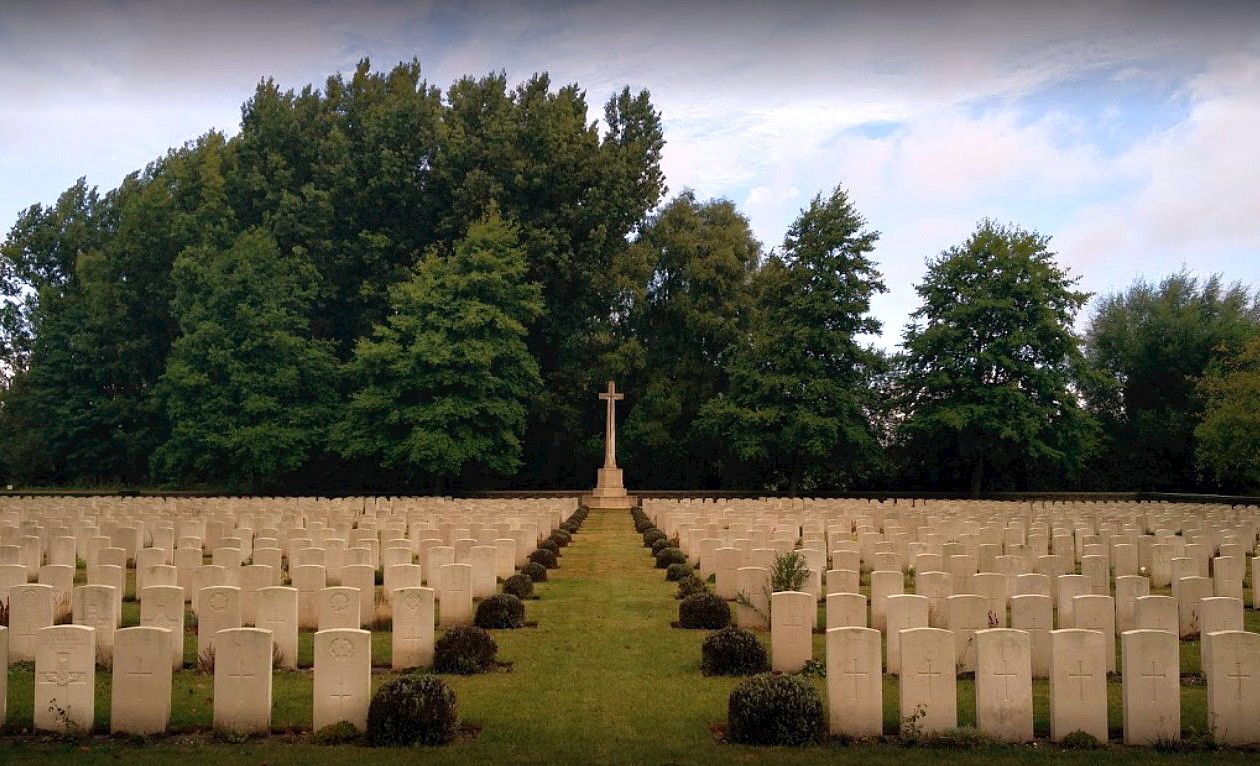
The Guards Cemetery, Windy Corner, Cuinchy,
France.
|
――――♦――――
A letter published in The Bucks Herald on 4th December 1915,
turned out, with hindsight, to be a particularly sad document.
It related to CORPORAL WILLIAM
SPINKS, D.C.M., 1st Battalion,
Hertfordshire Regiment, son of Harry and Charlotte Spinks of
Bunstrux Cottages, Tring. It read:
Your Commanding Officer and Brigade
Commander have informed me that you have distinguished yourself by
conspicuous bravery in the field on 27th September. I have read
their reports and, although promotion and decorations cannot be
given in every case, I should like you to know that your gallant
action is recognised and how greatly it is appreciated.
W. J. Horne
Major-General, 2nd Division
In November 1916, less than a year after being awarded of the D.C.M.,
[9] the following account appeared in the Tring
Parish Magazine:
Sergeant William Spinks, D.C.M.,
Hertfordshire Regiment, was a soldier of the best type. Long
before the war broke out, he heard the call of his country and
joined the Herts Territorials; and, before that, had done his drills
in the Church Lads’ Brigade. Early in the war he was sent to
France, and took his place with that ‘Contemptible Little Army’
which wrought such wonders, and endured such hardships, and to which
we can never be too grateful. So excellent was his service
that he made, in time, a sergeant, and for a very plucky bit of work
on 27 September 1915, he received the D.C.M. . . . .
William Spinks died, aged 25 years, killed by a German trench mortar
bomb; he was buried in a small military cemetery at Auchonvilliers,
France. The name of William’s brother, LANCE
CORPORAL CHARLES
EDWARD SPINKS, is also
engraved on the Tring War Memorial. Charles enlisted in the
Hertfordshire Regiment in 1915, later being transferred to the 7th
Bedfordshire Regiment. Aged only 22, he was killed by a
sniper, his death being all the more tragic for his two sisters and
younger brother, for both his parents died within 18 months of
William. Writing to The Bucks Herald after his death,
one of his friends says:
He was hit by a bullet on the night of
11th January [1918] and
died almost immediately. I took it to heart as much as if he
had been my own brother, as we have been together practically for
the last 18 months, side by side in most of the big battles.
It was hard lines for him, as he was not wanted for the trenches
until the last five minutes. He was buried in a cemetery
[Artillery Wood Cemetery, Boesinge, Belgium]
in as good conditions as can be expected.
――――♦――――
Published in The Bucks Herald on 11th December 1915 – from
someone who described himself as ‘A Tring Tommy’ on the Western
Front. PRIVATE GILBERT
SLADE, Army Service Corps, was a
baker’s assistant in civilian life and the son of Mr. A. W. Slade of
Longfield Road, Tring:
Dear Sir,
To give you news is out of the question, for two reasons.
First that the Censor is a particular chap, and second that we get
here very little news. Winter is fast settling upon us and
well we know it. The comforts of the bell tent are very
limited, and we house-dwellers of England care none too much for the
canvas mode of living. But we smile through it all, and look
to a time when we shall be able to return to Merrie England, and
settle down again the better Englishmen for being able to take our
part in the war for freedom, and for having realised our duty and
responded to it at the most critical period of the nation’s history.
We get along very well with the Belgians and the French; but of
course we are not expert linguists yet, and never shall be.
Suffice it to say we can make our needs understood and that means
much.
Yours sincerely,
Gilbert Slade,
‘One of the Tring-ites’
――――♦――――
The story of Edward Barber, the town’s only holder of the Victoria
Cross, has been told many times. An exceptionally daring young
man, he won his award for most conspicuous bravery at the Battle of
Neuve Chapelle on 12th March 1915, when “he ran speedily in front
of the Grenade Company to which he belonged and threw bombs at the
enemy, with such effect that a very large number of them at once
surrendered. When the Grenade Party reached Private Barber, they
found him quite alone and unsupported, with the enemy surrendering
all around him.” Edward was later killed by a German
sniper without learning of the honour that had been bestowed upon
him. Because his body was not recovered, his name is recorded
on the Le Touret Memorial, France. Private Barber’s Victoria
Cross is displayed at The Guards Regimental Headquarters at
Wellington Barracks, London.
From: HIS MAJESTY KING
GEORGE V. to the parents of PRIVATE
EDWARD BARBER, V.C., 1st Battalion Grenadier Guards.
To: Mrs Sarah Ann Barber, Miswell Lane,
Tring.
Buckingham Palace,
9th March 1915.
It is a matter of sincere regret to me that the death of Private
Edward Barber deprived me of the pride of personally conferring upon
him the Victoria Cross, the greatest of all rewards for valour and
devotion to duty.
George R.I.
Mr. and Mrs. William Barber experienced more grief when their
youngest son, PRIVATE ERNEST
BARBER, 1st Battalion Hertfordshire Regiment,
was reported missing after an engagement on 31st July 1917. He
had been taken prisoner and did eventually return home, but died
from his wounds in September 1920.
――――♦――――
An account relating to LANCE CORPORAL
FRANK KITCHING,
Northumberland Fusiliers, was published in The Bucks Herald,
on 1st July, 1916:
News has been received here that Lance
Corp. Frank Kitching has had the Distinguished Conduct Medal
conferred upon by the King. Lance Corp. Kitching married Miss
Poulton of Western Road while the 21st Division was billeted in
Tring. Referring to the award, the Regimental Magazine says
“…….. Lance Corp. Kitching of the Lewis Gun Detachment has been
awarded the DCM. During a heavy bombardment he was twice blown
up but each time returned to his gun. He must have
napooed [sic] a lot of
the enemy with his accurate fire.
Mrs Kitching received the following letter:
British Expeditionary Force,
25 May 1916.
Dear Mrs. Kitching,
I am writing to you inform you that your husband has been awarded
the D.C.M. medal for his gallant conduct on Sunday 30 April.
Please convey to him the congratulations of all officers and men of
this Battalion and especially of the Machine Gun Section. We
are proud of him. I was sorry he was wounded but pleased to
know his wounds are not serious; and we trust he will soon recover
and be able to re-join us out here. . . . .
Yours sincerely,
John McKinnon
――――♦――――
 |
|
Memorial plaques to William
and Charles Spinks.
Issued by the Government to relatives of all who died in
the war, they were nicknamed
Dead Man’s Penny, Death Penny, Death Plaque or Widow’s
Penny. |
|
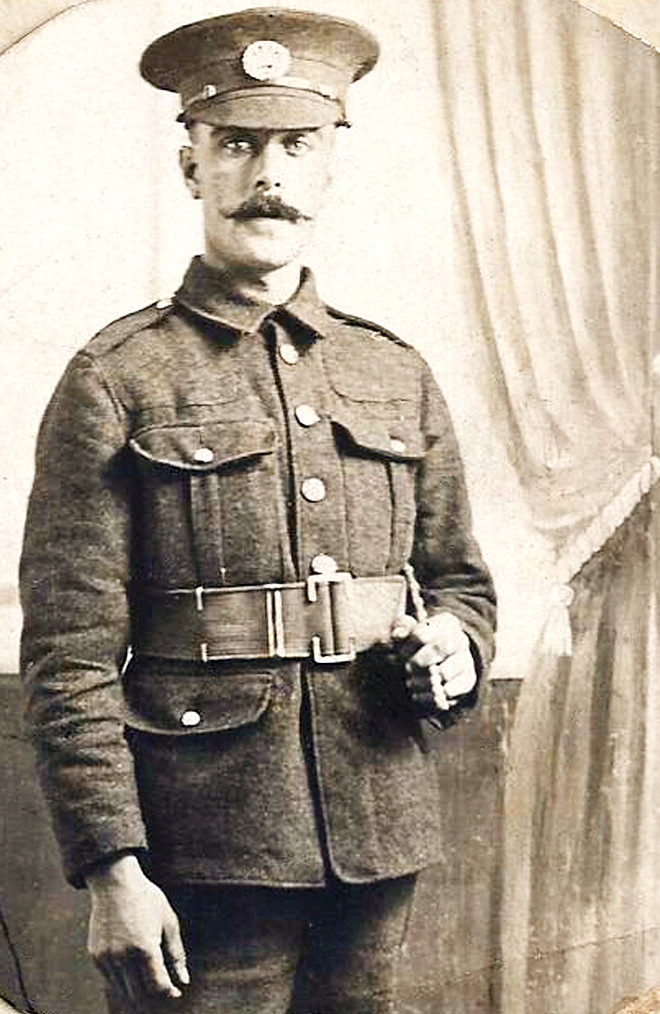 |
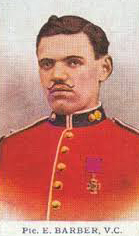 |
|
Above, Private Edward
Barber, V.C.,
1st Battalion Grenadier Guards.
Left, Private Sidney Fountain, 1st Battalion,
Cambridgeshire Regiment. |
|
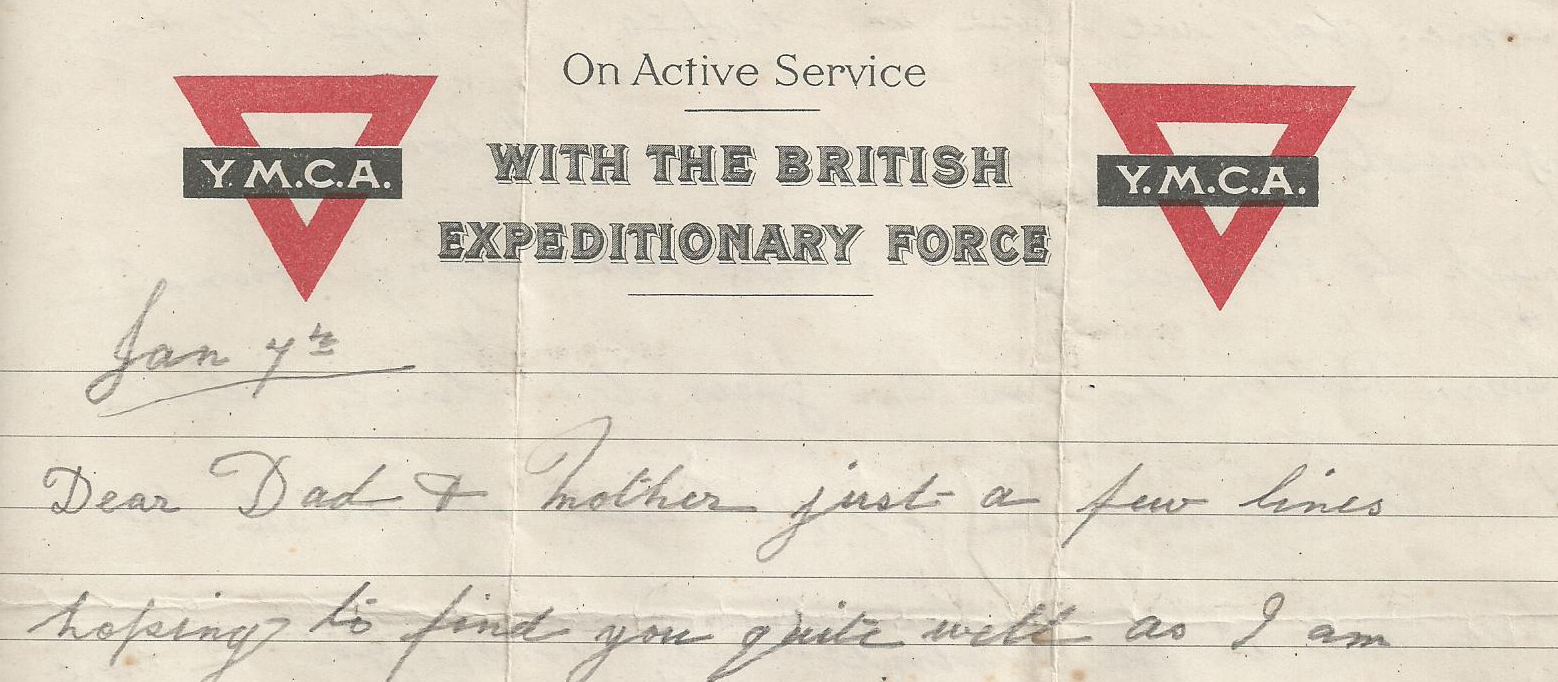 |
|
The beginning of
Sydney
Fountain’s letter to his parents. |
|
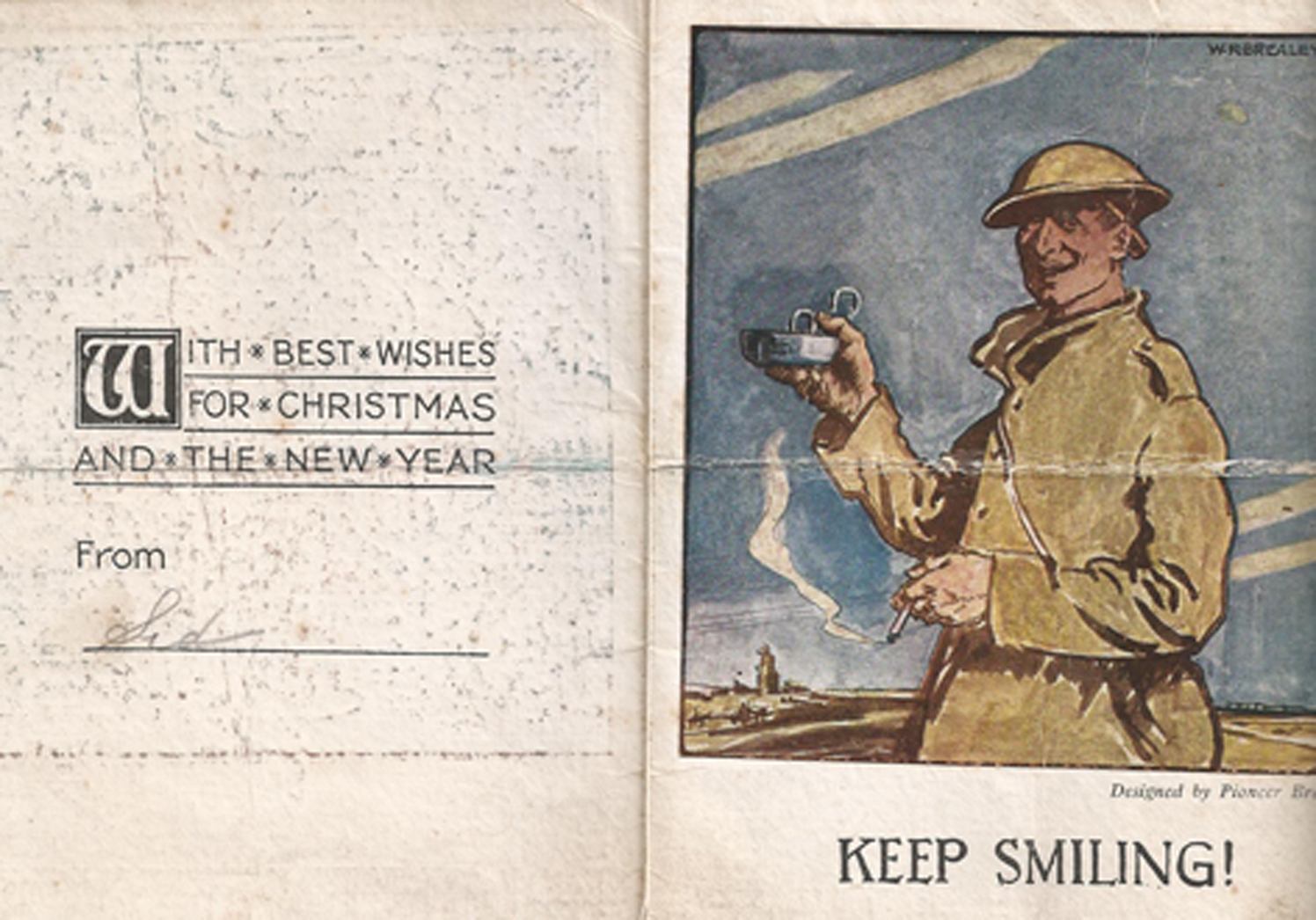 |
|
An example of a typical
Christmas card sent from the Front . . . .
from Sidney Fountain to his parents in 1917. |
|
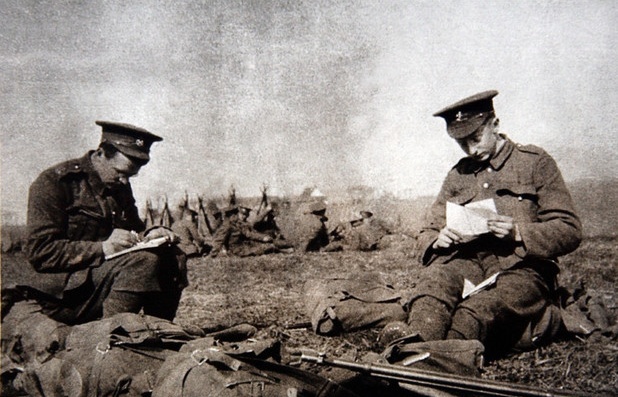 |
|
Tommies keeping in touch
with their loved ones. |
Several Tring men fell during the course of the protracted battle on
the Somme in 1916, among them 2nd LIEUTENANT ANDREW
CRANSTOUN BROWN,
8th Battalion South Staffordshire Regiment. Killed in action
during what was termed ‘The Big Push’, he was the 21-year old son of
the late Dr. James Brown of Aylesbury Road, Tring, who had died
early in the war. He is buried in the Danzig Alley British
Cemetery, Mametz, France, and is also commemorated on his father’s
memorial stone in Tring Cemetery. Shortly after his death,
Andrew’s mother received this letter from one his men:
I always thought when I got back to
England that I should like to tell you the brave way in which your
son died and how he led us. That day he was quite cool all the
time and one of our boys, after we had advanced over three lines of
trenches and were lying down, said to Lt. Brown ‘That trench is full
of them, Sir’. He got up on his knees, put his glasses to his
face to observe them, when he had a bullet through the head.
We were all dumbfounded.
A great mark of respect was offered to Lt. Brown when about three
days later, his Platoon had fallen back a bit and his body was
brought down and lay quite close to us on a stretcher. A
German battalion which had surrendered was coming down and we could
see them being led on, when suddenly, as they got to where we were,
the German commander pulled up the lot and turned to salute, which
we thought was funny. But again we looked, but it was the
salute to the dead body of our Lt. Brown. This thing impressed
me very much. I always said if I got back I would let his
people know.
You will, perhaps, pardon me as a private soldier. I admired
and respected your son.
――――♦――――
From: (dating probably 1918): PRIVATE SIDNEY
THOMAS FOUNTAIN,
1st Battalion Cambridgeshire Regiment:
Dear Dad and Mother,
. . . . myself. I received the parcel alright and was very
pleased with it. Pleased you enjoyed yourself at Xmas. I
spent my Xmas night and Boxing Day in the trenches, but we are right
back now. We had our New Year’s supper last night, plenty to
eat and drink and with your parcel I had quite a good time.
Pleased to hear Jack is coming home, hope he is quite well, I should
like to be at home to see him but I hope we shall some day. We
live in hopes. I hope to have my next Xmas at home.
I don’t think much to France, just about like being round Swan
Bottom. So you can guess it is lively. Tell Dad to
remember me at The Castle. They dish the beer out in pails
about here. I have got two more parcels to come Sarah
[his wife] tells me, so I shall
be alright. They are a long time coming sometimes. This
is about all this time, wishing you a happy New Year, hoping to see
you all again someday, from Sid.
Aged 29, Sidney Fountain lived with his parents, wife and two
children in Charles Street, Tring, where he worked for the Co-op as
a car-man. He joined the Army in 1916 in the Northants
Regiment, and transferred later to the Cambridgeshire Regiment,
being posted to the Front in June 1917. Sidney was not granted
the last wish in his letter above — to see his family again — for he
was killed in action by shellfire on the Somme towards the end of
the war (28th August 1918). He is buried in Perronne Road
Cemetery, Maricourt near Albert, France.
Published in Tring Parish Magazine — from an OFFICER
IN THE ROYAL ENGINEERS
(Signals) 3 April 1918 —
At last! After twelve of the most
strenuous and exciting days I have ever known, remnants of us are
safely out for a bit in a green field, able to sleep. Ever
since the fight began we have been at it all day and all night –
fighting, marching, retreating, counter-attacking etc. etc.
Out of the 12 nights of the fight I was four nights without a wink
of sleep, and have certainly not averaged three hours of sleep out
of 24 for the rest of the 12 days. Never had boots off except
once to wash my feet, shaved about three times, washed hands and
face about every other day; and with it all I have been wonderfully
and marvellously fit – huge appetite and perfect digestion; walked
and ridden countless miles without fatigue or soreness and come
right through it without a scratch. A wonderful experience!
Yesterday we came out of the fight battered and dirty but still
cheerful. I ended up by an all-night march of 24 miles, so
tired and sleepy that I could not remain on my horse, but had to
walk to keep awake, after which I slept all morning, most of the
afternoon, and all night and still could do with more.
The Signal Company has been pretty fortunate on the whole in the way
of casualties, one officer killed and some valuable NCOs but very
few men and only three horses.
When we are refitted we will, I suppose, enter the fight again with
renewed vigour. The end is not yet, and though the Hun has won
the first act, it does not follow he has won the rubber. Our
post has been held up from the start but I have received it
altogether yesterday.
|
Waste of blood and waste of tears,
Waste of youth’s most precious years.
Geoffrey Studdert Kennedy |
|
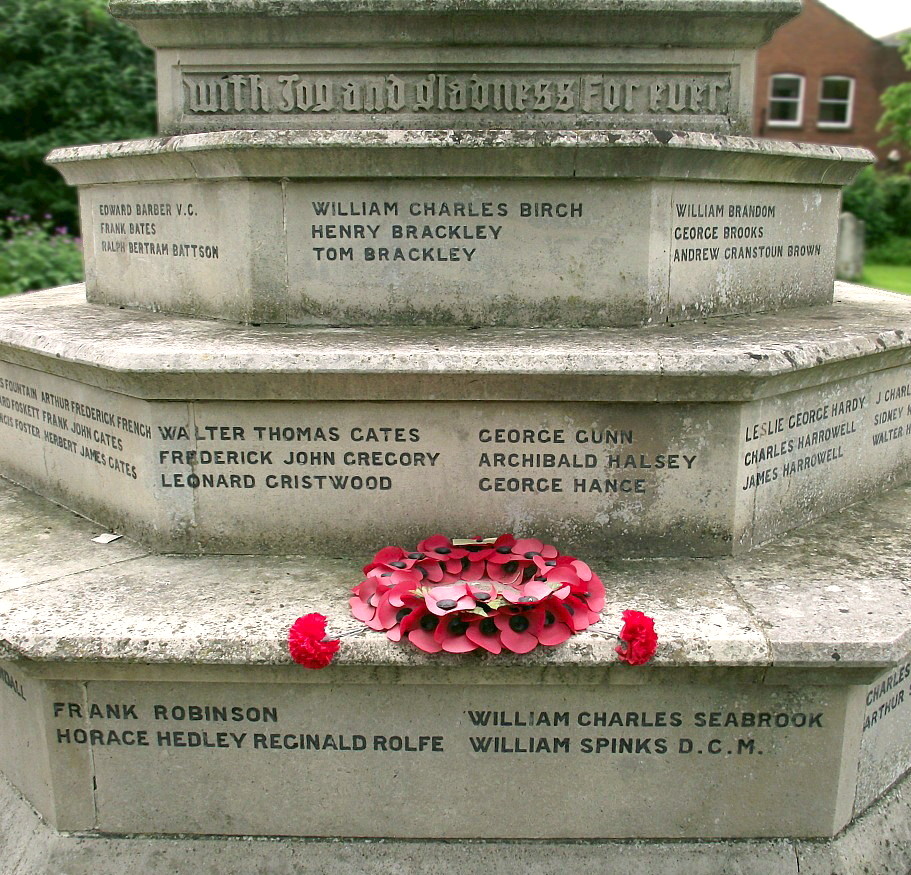
Tring War Memorial
[Appendix].
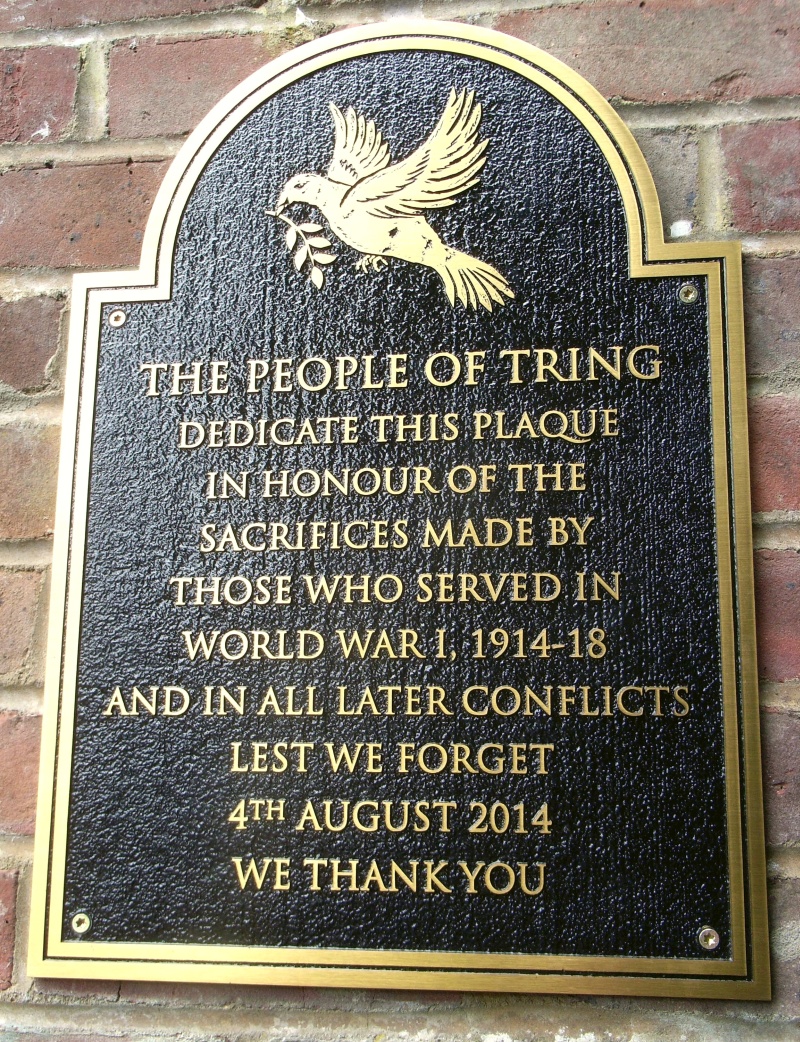
Plaque on the gatepost of Tring Memorial
Gardens.
――――♦――――
|
LETTERS
FROM
OTHER
THEATRES
OF
WAR
In August 1915, SERGEANT FRANK
SHEERMAN, Royal Bucks Hussars, was
wounded in action in the Gallipoli campaign and invalided home
shortly afterwards. His parents received this letter from his
great friend Frank Nash of Aylesbury, also badly wounded and in
hospital in Cheshire:
We had orders to march across the Salt
Lake (a death trap) on 21st August. When we were about a
quarter of a mile across the Turks spotted us, and poured shot and
shrapnel at us for all they were worth. It was like a
thunder-storm. Our men kept falling around us, but we marched
on all gay as if on a route march. Believe me, it was the best
march I have had, for it made one feel proud to be with such a
gallant lot of boys.
When we were about a mile and a half across, Frank got hit in his
left hand. I am almost sure it was only his fingers that were
hit, because Frank was in the front of the troop and I was just
behind him, and some of the shrapnel hit my boot at the same time.
Well, we got under Chocolate Hill, and I asked Frank if he was hurt
anywhere beside his finger, and he said he did not know; but he felt
very bad. He looked very white, and walked lame. I
thought at the time he might have a slight rupture, as he laid down
under Chocolate Hill as soon as we stopped, and it was a job to
avoid laying on one’s water-bottle with all our Infantry equipment
on. We left Frank behind with the doctor, as we had to get
into touch with “Mr Turk” and do some dirty work with our bayonets .
. . .
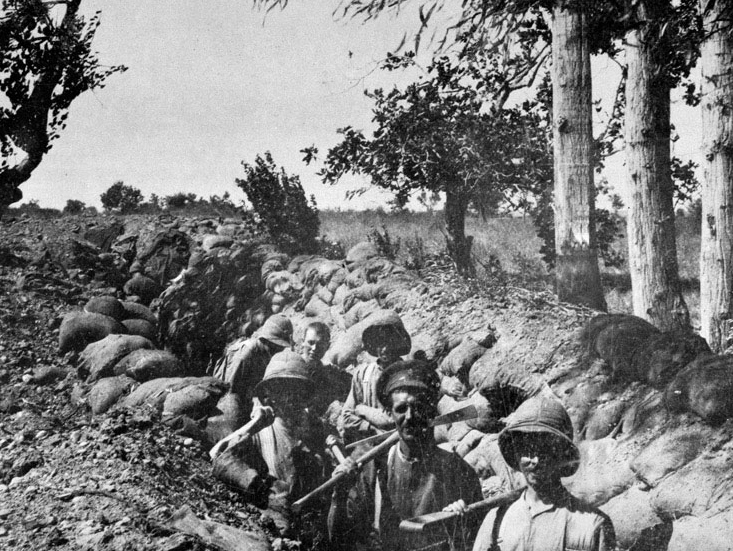
British troops dig in on Chocolate Hill,
Sulva Bay. This attempt in August 1915 to break the
deadlock
of the Battle of Gallipoli was
unsuccessful, and Sulva Bay was evacuated a few months later.
About the time the above letter was received, Frank Sheerman’s
parents also heard directly from their son then lying in hospital in
Plymouth:
You must think you have got one of the
luckiest sons on God’s earth, firstly for his being spared in that
terrible attack on the 21st August (a day that will never be
forgotten); and secondly for his being fortunate enough to be
brought to England, while so many thousands of others only go to
Alexandria, Cairo or Port Said. Well, my wound is not very
serious. I am hit in the lower part of the abdomen, and I have
got to undergo an operation here; but I am very confident of coming
through all right, and being none the worse afterwards. We
lost heavily, I believe, but have not seen the regimental
casualties; so if you can give me any particulars which may have
been published, I should like to see them.
After a rough voyage we arrived in Plymouth Harbour on Friday, and
were moved here. All now that we have been through seems like
a bad dream; a hot bath and clean shirt (minus the wee midges), to
say nothing of a spring mattress, being fair compensation for a lot
of hardships. Chocolate Hill, the hill we are trying to
capture is 907 ft. high, and rises straight from the beach, so you
can tell what it is like trying to climb up and do bayonet charges,
carrying 250 rounds of ammunition. . . . . If it had not been
for my mess tin (full of Army biscuits) which the pieces of shell
struck first, I should have been killed outright . . . .
Frank Sheerman did recover sufficiently from his wounds and
subsequent operation to re-join his regiment, the Royal Bucks
Hussars. In November 1916 he was appointed Depot
Sergeant-Major at Buckingham, his duties including responsibility
for enlistment, clothing and the posting of recruits.
――――♦――――
|
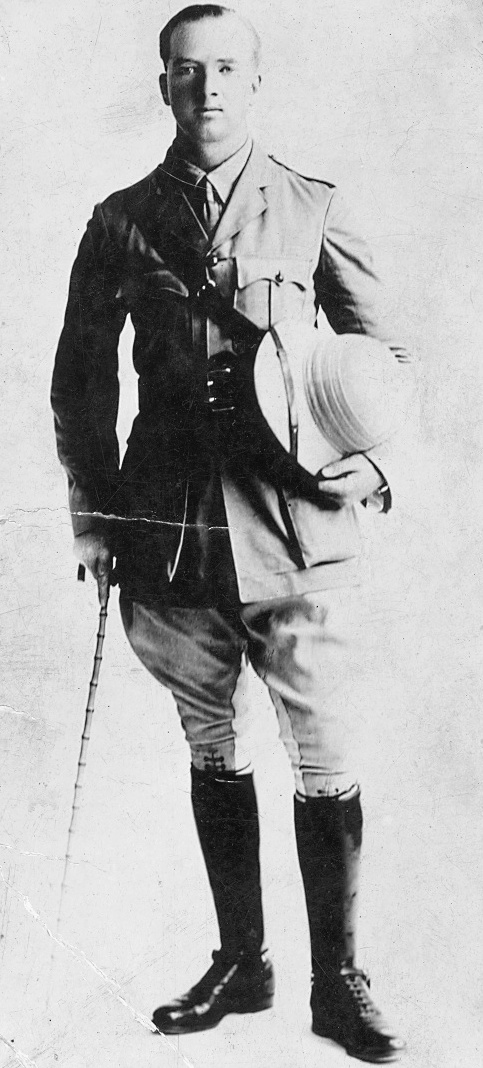 |
|
Lieut. Samuel Kesley. |
Serving in the same regiment was LIEUTENANT SAMUEL
KESLEY of Miswell Lane, Tring, a
sorting clerk and telegraphist in civilian life. Samuel
enlisted early in the war, in September 1914, and was invalided home
from the Dardanelles a year later suffering from enteric fever from
which he recovered. Posted abroad again, in June 1918 he wrote
a letter from Palestine, which was published in Tring Parish
Magazine. Due to censorship one can only guess at his
exact role in the Middle East campaign: [10]
I have been moved from camels to
donkeys. The corps is under the same administration as camels,
and is newly formed so of course it has to be officered, and I have
been selected as one of them and posted to No.1. It really is
a big scream. I wish you could hear the noise at feeding time.
I have 500 of them, and it is a regular Donnybrook!
[a horse fair in Dublin. Ed.] Of
course I am no longer on the Coastal sector and probably shall have
a chance of getting to Jerusalem which is about 25 miles distant but
the country is about the worst I have ever struck. It is very
mountainous with hardly any cultivation and the mountains are
covered with huge boulders of rock and only donkeys can get about
them with the exception of goats. But they are not forming a
goat corps yet! We seem to be away from the world here, away
in the hills. Everything is very quiet except for the hum of
an aeroplane; it seems almost living a hermit’s life.
Later: At last I have seen Jerusalem. Just before entering the
city, Neby Sainwil, the traditional tomb of the prophet Samuel, is
clearly visible from the road. This is where some of the
stiffest fighting took place and one cannot understand how our boys
overcame such strong positions, it was superhuman. I took a
guide to the Holy Sepulchre, there I saw Our Lord’s tomb. The
church which it is built over is very beautiful inside. I
cannot say what passed through my mind as I stood by the side of His
tomb, but everything seemed to be at peace. I also saw the
mosque of Omar, the Jews’ waiting place, and the Garden of
Gethsemane. It is hard to realise all that happened here.
――――♦――――
Minna Jordan, of Hildene, Aylesbury Road, [now the site of St
Joseph’s Retirement Home] wife of one of the curators at the
Zoological Museum [The German Connection] maintained a regular correspondence with men serving
abroad. For instance this, written in pencil:
4th October 1918
Signal Section, 77th Infy. Brigade Headquarters,
British Salonika Force.
Dear Mrs. Jordan,
You have no doubt heard that this little war is all over. We
are looking forward to having a quiet winter. A fortnight ago
we had rather a lurid period, but just now we are sitting quietly in
a fertile valley in Bulgaria, doing nothing.
There is a rumour of another move, but I think it will only be a
short one. By the time you receive this it will be just a year
since I was last at Tring. Isn’t it a fearfully long time . .
. .
I am afraid there is not much hope of us returning to England now.
I am afraid they are more likely to send us to a cheerful place like
Albania. However, I am due to have leave in about a year’s
time. I enclose my latest photograph. It is really
intended to be principally a photograph of my horses. The one
I am riding is Mike, who is large, beautiful and stupid; the one the
groom is riding is Rajah. He is old and ugly but very fast.
There is very little news of interest. I am quite well.
I have passed through the summer with no malaria.
With best wishes to all at Tring,
Yours sincerely,
Robert H [surname illegible]
|
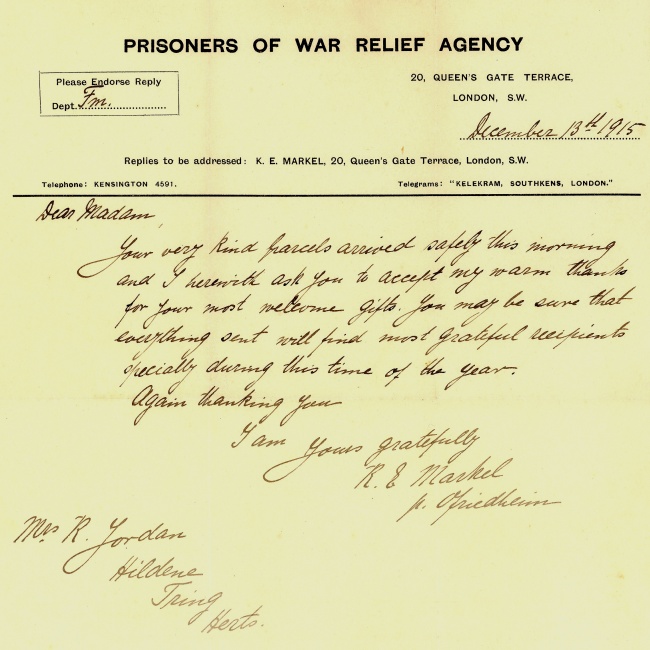 |
|
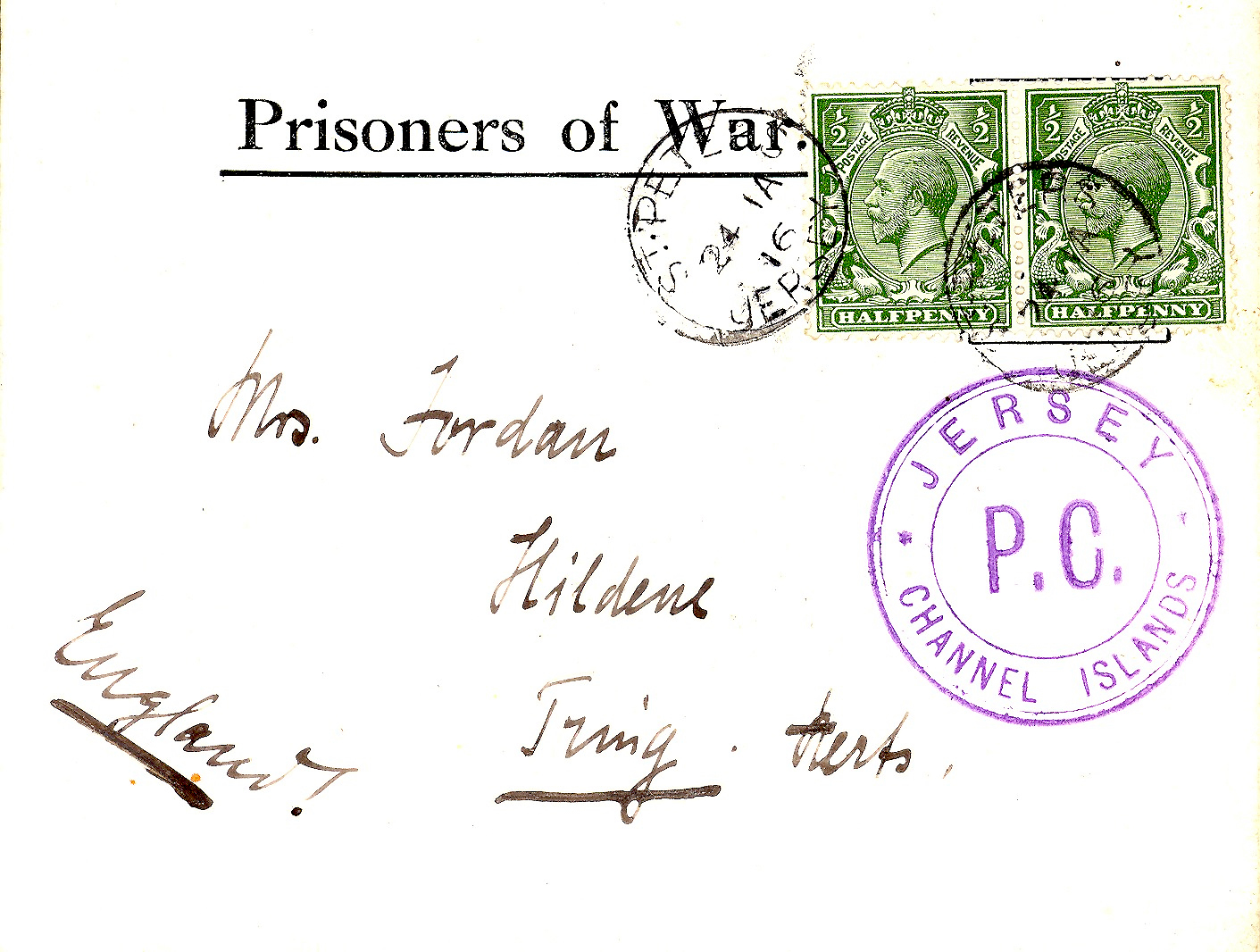 |
From Hans Michael, Jersey
Camp, Channel Islands. |
PRIVATE GEORGE DELDERFIELD
of the School House, Tring, had been missing for some time, but in
June 1918 his wife received a letter from him saying he was quite
well and being held prisoner in Bulgaria. He was engaged in
gardening, an occupation of which he was quite fond, and his only
need was a supply of clothing.
Other Tring men in the armed forces found themselves in far-flung
corners of the conflict that claimed less attention than France and
Belgium. Some served in Gallipoli, Italy, Mesopotamia, Egypt,
Lebanon, Palestine, German East Africa, and Syria, and among those
who died are:
PRIVATE JOHN RUSSELL
HEDGES, 1st/5th Battalion Bedfordshire
Regiment, died of pneumonia in Palestine in a field ambulance five
days after the Armistice in November 1918. He is buried in
Beirut, Lebanon. His chaplain wrote to his mother “We laid
your son to rest at Mar Tatlar, near Essafa, on a gentle slope
overlooking the sea, and his funeral (with military honours) was a
most impressive one”. On the same day, PRIVATE
ARTHUR LOVELL,
54th Machine Gun Corps, Norfolk Regiment, died of malaria in Lebanon
and is also buried in Beirut; his brother, LANCE-CORPORAL
FREDERICK LOVELL,
had been killed in France two years earlier.
LANCE-CORPORAL WALTER
RANCE, 2nd Queen’s Royal West Surrey
Regiment, was killed in action on 30th October 1918, and lies in
Tezze British Cemetery north of Venice. He had been a member
of Tring YMCA and the local Fire Brigade, before enlisting in 1916,
being posted first to France where he was wounded, and then for 12
months to Italy where he took part in the last big offensive against
the Austrians.
CORPORAL STANLEY MILLER,
1st Bucks Hussars, after surviving the Gallipoli campaign, was
transferred to the Palestine Expeditionary Force. He was
wounded severely on 1st June 1917 by what was described as a “piece
of bomb dropped from an aeroplane”; he died the following day in
an Australian stationary hospital and was buried in Kantara War
Memorial Cemetery, Egypt, on the eastern side of the Suez Canal.
Two days later PRIVATE ERNEST
GEORGE WRIGHT,
4th Battalion Essex Regiment, of Brook Street, Tring, who saw
service in France before being posted to Palestine, was laid to rest
in the same cemetery.
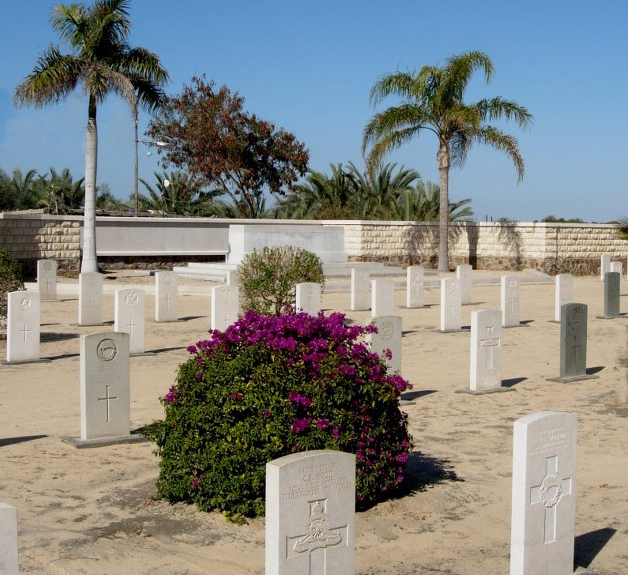
Kantara War Memorial Cemetery.
|
If I should die, think only
this of me:
That there’s some corner of a foreign field
That is forever England.
Sub-Lieut. Rupert Brooke [11] |
――――♦―――― |
|
LETTERS AND
PARCELS
As the war dragged on towards the end of its third year, William
Mead, owner of the Tring Flour Mill at Gamnel and a great local
benefactor, sent a Christmas parcel to each man, not only to those
who worked for him at the mill or on his farms, but to every New
Mill lad serving abroad. Twenty-six parcels were despatched to
France in response to which William Mead received eleven letters of
acknowledgment. These he pasted into a scrap book, preserved by his
granddaughter, from which the following five are taken.
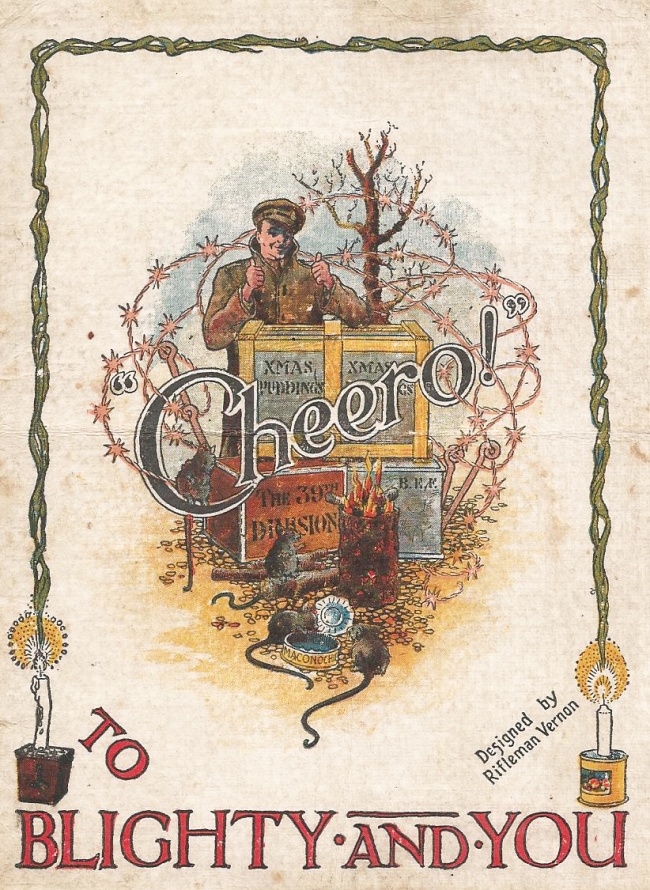
A ‘thank-you for parcels’ — Christmas
card sent from France to Tring.
From PRIVATE JAMES GREGORY: 20727, 7th Platoon, B. Coy. 4th
Battalion, Beds Regiment, B.E.F. (in pencil):
Dear Sir,
I am writing a line to thank you for your kindness in sending me the
Xmas parcel which I received safe and sound and I am sure came very
acceptable, also on behalf of my brother Fred I must thank you as he
was killed in our last great advance. He died a brave lad doing his
duty as a Signaller for our Company. He was greatly respected by his
mother and the rule is to share out all parcels with their platoon
mates. We are expecting to soon be in the firing line again.
Wishing you and Mrs Mead a Happy New Year, I remain, yours truly, J.
Gregory.
PRIVATE FREDERICK JOHN
GREGORY, in the same regiment and battalion
as his brother, was killed in action on 14th November 1916. His name
appears on the Thiepval Memorial (soldiers with no known grave) in
France. The Tring Parish Magazine recorded
“. . . .
Frederick Gregory
was killed as he left the trenches. He joined the Army two years
ago, and has been at the front for the past six months. He is
another of our Church Lads’ Brigade boys to lay down his life in
this war . . . .”
――――♦――――
From GUNNER JOHN NUTKINS: 74795, Royal Field Artillery, B. Battery,
124th Brigade, B.E.F. (written in pencil on paper torn from a pocket
book):
Dear Sir,
Just a line to thank you for the parcel which I received on the 28th
as it came in very handy as we have had it a bit rough lately but I
am like all the others making the best of it we have had some very
rough weather out here hoping you are getting better weather hoping
you had a merry Xmas and happy New Year.
Thanking you again, I remain, yours sincerely J. Nutkins.
――――♦――――
From PRIVATE JOSEPH KEEN: 129973, 2nd Suffolk Co., 3rd Division, B.E.F. (in pencil with a drawing on the envelope):
The Front,
31st Dec. 1916
Sir,
Please accept my best thanks for the nice parcel of “goodies”
received from you today. My mates and self have heartily enjoyed the
contents as a great change from the monotony of Army fare. Please
accept my best wishes for Peace and Prosperity for 1917.
Yours gratefully,
Joseph Keen.
――――♦――――
From PRIVATE EUSTACE PHEASANT: 4438 Headquarters Company, 1st Herts. Regiment, B.E.F. (in pencil):
1st January 1917
Dear Sir,
I am write to thank you very much for the parcel you sent me for
Christmas. It is very kind of you to think of us at such a season,
as of course we are all thinking of the homeland, and it makes us
very grateful to know that we are not forgotten by those at home. We
spent Christmas in the trenches where your parcel reached me, and
the contents were thoroughly enjoyed by my comrades and myself.
The Battalion was lucky enough to have no-one killed on Christmas
Day and only one wounded, so you will guess it was rather a quiet
day. It is very wet and muddy in the trenches this time of the year
and we have to wear gum boots to save getting frostbitten feet, so
you can imagine the state of the trenches in this part. Still
everything is done to make it as good as possible for us, and
altogether we did not spend such an awful Christmas as one might
think. I am sure I am very grateful to you for your kindness and
wish you every success in this New Year.
I remain, yours truly,
E. R. Pheasant
――――♦――――
From DRIVER ERNEST WRIGHT: 3023980, No.3 Company, A.S.C., 20th
Division (in very faint pencil):
Dear Sir,
Glad to say I have received your very nice parcel quite safely for
which I send my warmest thanks. I am sure I enjoyed the contents
immensely by the way. We spent Christmas very quietly out here, as
our Div. were rather unsettled so we kept our Christmas festival up
on Boxing Day and had a fairly good time under the circumstances, as
I also hope you did. Well, I do not think we shall see another Xmas
out here ‘hope not anyway’; as I think the End is now in sight by
what Mother tells me. You also have been having the weather very
rough the ground is in a terrible state here, we even have to have
eight horses on a water-cart. Still I have been very fortunate in
being an Officer’s Servant as I have a great many advantages. I do
not think I should be long now before getting my leave, at the
present rate any turn comes at the beginning of Feb. Well I must now
conclude.
Wishing to be remembered to Mrs Mead,
I remain,
Yours truly, Wright E. J.
――――♦――――
Letter to EDITH, WIFE OF WILLIAM
MEAD, headed 4th King’s B.E.F. (in
pencil, on yellowing torn paper):
15th October 1916
My Dear Mrs. Mead,
Thank you very much for your letter which I was very pleased to
receive, you seem to have been having a really old time of it. I had
quite a good time down at a seaside place but was recalled too soon,
and I had only just got to know the place but still I had quite a
good time while I was there, but coming back I was lost for 4 days
and travelled backwards and forwards without arriving at my final
destination.
How is Mr. Mead and the kiddies, please give my love to both. I
shall remember the good old times I had at “Gamnel”. The weather out
here is pretty wretched, still taking all things into consideration
it is not always so bad as we always have some nights when we get
relieved and have a good time until we go into the line again. I
myself have been on reconnaissance duty lately which I don’t like at
all, it is too lonely altogether. I don’t mind shells when I am with
somebody as one can listen for it coming and then watch the
direction it comes from. But it is far too trying a job doing both
things by yourself. I wrote to Gladys yesterday, how is Dr Clark
please? Remember me to him, also Mr. & Mrs. Honour [?]). I may see
Graham out here, do you know what Division he is in? I had a letter
from old Leslie the other day; he does not seem to be very hopeful
about his eyes [Ed. presumably a wounded friend from home.]
You must excuse pencil and scrawl etc. but it is the best I can
obtain under the present circumstances [damaged section follows]
. . . . Ernest is still carrying on and I am glad he has got exemption. My
love to him and ask him to drop a line when he has time.
Cheeryho for now. I remain, Always your loving friend, ?? [signature
illegible].
――――♦――――
William Mead’s contribution to the war effort had been unceasing. During the period that the soldiers of the Northumberland Fusiliers
and other northern regiments were billeted in Tring, he fitted an
annexe to the mill containing two enormous baths for their use. The
photograph above is an example of the hospitality and entertainment
he arranged at intervals for wounded servicemen both in the garden
of his home, and on the adjacent canal. One newspaper account tells
us that he also invited wounded British and French soldiers for
drives around the countryside in his steam lorry, finishing with
refreshments and games at the mill; those too ill to attend he
visited in the various local military hospitals. And after the war,
William Mead arranged the collection and re-erection of a sizable
army hut, complete with stove, which was sited at the central point
of Gamnel. Periodically refurbished, it served as a Community Centre for a great variety of
activities for nearly a hundred years. [12] |
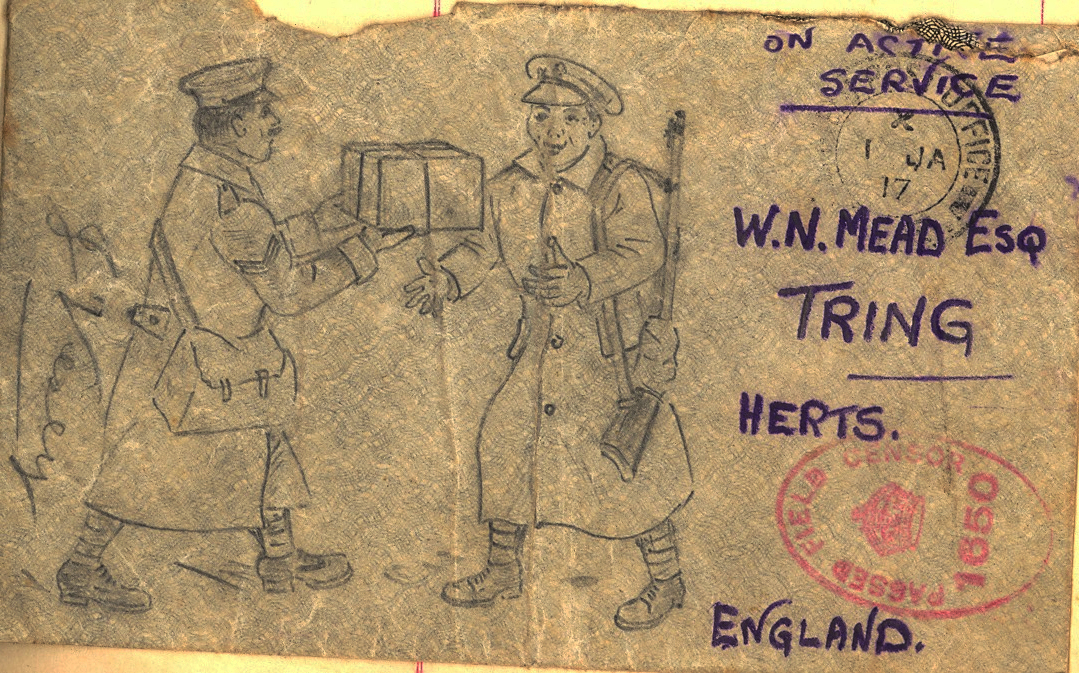
Envelope from Private
Joseph Keen.
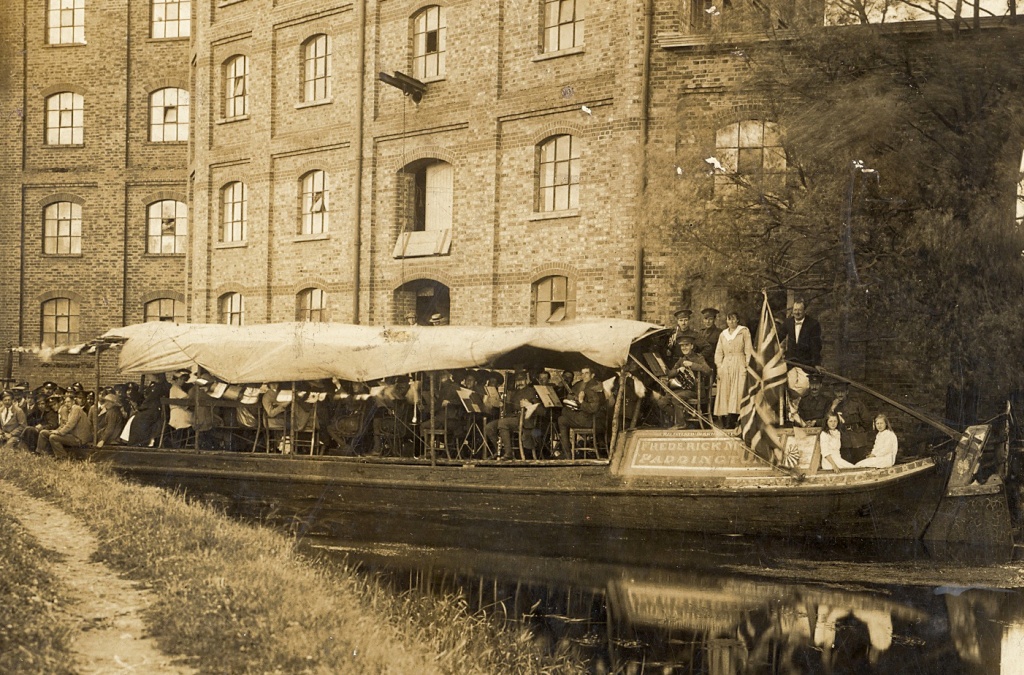
|
Outside Tring Flour Mill at
Gamnel on the Wendover Arm. The Mead family
entertain wounded soldiers and airmen from Halton Camp
on board one of the firm’s narrow boats, 1918 — note the
bandsmen seated beneath the awning. |
William Mead’s effort had been part of a general desire in the town
to let the men know they were not forgotten at Christmas. An account
appearing in The Bucks Herald just after Christmas 1916 gives some
idea of the type of gifts that the parcels contained:
On the suggestion of the Rev. H. Francis
[Vicar of Tring] a representative
committee had been formed, and a number of ladies undertook to
collect the necessary funds . . . .
Donations per lady collector, and others with special donations to
clear the deficit, amounted to £99.19s.0d. . . . . The contents of the
parcels (the number exceeding 300) were supplied by 27 tradesmen of
Tring. A Christmas card, a cake, OXO, cigarettes, soap,
writing pad with paper and envelopes, towel, and a note explaining
that the parcel was a gift from their fellow townsmen in
appreciation of all they were doing and bearing for King and
country, and a box of chocolates and bit of holly were put into
every parcel. The YMCA also added extra cigarettes.
Scores of letters acknowledging receipt of the parcels have already
come in, showing how much the men appreciated not only the things,
but the kind spirit and remembrance which the gifts betokened.
Those who subscribed (772 in all) were well pleased to know how much
their gifts were appreciated . . . .
A year previously, real concern was being felt for the men who had
been taken prisoner, and the Cockburn family of Red Lodge, Miswell
Lane, decided to do something about it. The following letters were
printed in the The Bucks Herald:
Tring,
9th November 1915
Sir,
Many of our men who were taken prisoner have now experienced twelve
months captivity in German hands, and we gather from those who have
been fortunate enough to return home that if those left behind are
to survive a second winter in that rigorous climate, it is
absolutely essential that they should receive warm clothing and food
regularly.
We ask, therefore, for contributions in money or in kind – even a
stick of chocolate or a cake of soap will be welcome – and old
underclothing, if warm and in thoroughly good condition, may be
sent. The following list of the most useful articles to send is
supplied by the Prisoners of War Help Committee in London:
Tea, Cocoa Handkerchiefs
Tinned meats Soap, carbolic soap too
Biscuits, cheese Pencils, tooth-brushes
Chocolate Towels
Plasmon chocolate, Bovril Gloves, mittens
Tinned vegetables Draughts, dominoes etc.
Sugar Needles, cottons, buttons
Dried fruits Tobacco, pipes, cigarettes
Force, Grape Nuts Shaving brushes
Will friends order from their grocers a weekly parcel to be sent? The cost need not be great. The benefit to the prisoners will be
immense. These gallant men were fighting our battles till evil fate
overtook them; for us they shed their blood and lost their freedom.
We are now given an opportunity to repay (in part) the debt we owe
them.
Yours faithfully,
J. Cockburn
This letter had the desired result, and Miss Cockburn undertook the
collection and despatch of parcels:
48 Charles Street,
Berkeley Square,
London, W.
My dear Miss Cockburn,
The contents of your glorious box full of comforts will be for the
most part on their way tomorrow. The great coats are quite
splendid. The gloves, mitts, jerseys etc. are most useful.
Some contributors write their names and addresses on the cigarettes,
and I am sorry to say I had to scratch it off, as no scrap of
writing may go through, and if it does there is the chance of the
parcel’s owner being ill-treated, so we have to be very careful.
Helen Woodward,
Lady Burghclere’s Fund
|
If I were fierce, and bald,
and short of breath,
I’d live with scarlet Majors at the Base, [13]
And speed glum heroes up the line to death.
You’d see me with my puffy petulant face,
Guzzling and gulping in the best hotel,
Reading the Roll of Honour. ‘Poor young chap,’
I’d say — ‘I used to know his father well.
Yes, we’ve lost heavily in this last scrap.’
And when the war is done and youth stone dead,
I’d toddle safely home and die — in bed.
Captain Siegfried Sassoon, M.C. |
――――♦―――― |
|
LETTERS
FROM
CLERGYMEN
From the REVEREND CHARLES
PEARCE, Minister of the United Free
Church in Tring High Street, to The Editor of The Bucks Herald:
Fernlea, High Street, Tring.
10th November 1915.
Dear Sir,
|
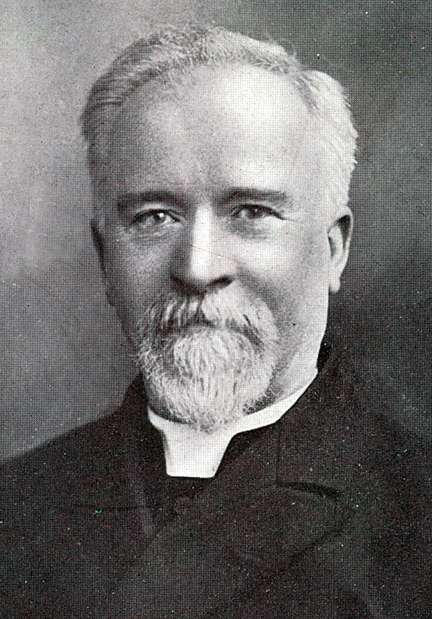 |
|
The Rev. Charles Pearce. |
Much, but not too much, has been written about the officers and men
of Halton Camp and at the Front. I believe you will think a
line or two about our Hospitals worthy a place in your valuable
paper. Neither rose nor rainbow gain anything from painter or
poet, and deeds of mercy require no flourish of the pen. A
simple statement will be enough to show the skill, sympathy, and
success of the doctors, their staff, and assistants. We have
had three Military Hospitals in Tring for considerably over 12
months (a number of the wounded from the Front are now here); but,
as far as I remember, we have had only three deaths. Surely
this must form a record. Some of these were very seriously ill
before admittance. I have been deeply touched by the tears in
the tone: “We did our very best, but could not save him”. The
men seem to have undoubted confidence in the medical staff and their
helpers. The monotony of indoor life is just now largely
increased by the darkened windows. But all are hopeful of
brighter days.
Yours etc.,
Charles Pearce,
(Army Chaplain)
Later in the war, in addition to his already considerable duties,
Reverend Pearce received the distinction of being appointed
Officiating Chaplain in local military hospitals to the Wesleyans,
Presbyterians, Congregationalists, Primitive and United Methodists,
and Baptists, thus filling the unique position of representing all
of the Free Churches.
――――♦――――
From: ACTING CHAPLAIN TO
THE FORCES GUY
BEECH: [14]
19th December 1915.
My dear Friends,
|
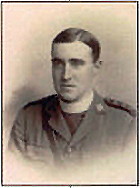 |
|
Rev. Guy Beech. |
As most of you will know before this letter is published, I have
been appointed to temporary duty as an Acting Chaplain to the
Forces. I shall therefore be leaving Tring for a time after
Christmas; but, at least for the present, I am not going far away .
. . .
It is with much regret that I leave the Vicar, and the Parish with
an incomplete staff of clergy, but those in authority over me in the
Diocese consider that I can reasonably be spared from here at this
time of crisis in Church and Nation.
You will, I am confident, readily forego some of the spiritual
ministrations to which you have been accustomed in your country’s
hour of need. May I further appeal to all who can do so to
offer their help, each in his or her several capacity, in the work
of the Church at this time. We ought not to expect everything
as usual, but much of the Parish work, notably the Sunday Schools,
can hardly be carried on at all unless new helpers will come forward
to take the place of those who have been called away on active
service . . . . The services of intercession in connection
with the war, in which I have taken part with you week by week for
so long will have a very special place in my thoughts when I am
away.
Your faithful servant
Guy Beech
Later Guy Beech was posted “somewhere far away”. He did
not return to Tring after the war, going instead to the Rectory of
Turvey, near Bedford. He wrote from France on 3rd May 1918:
As the address shows you, I am now
attached to ‘The Diehards’ [nickname for the
Middlesex Regiment, Duke’s of Cambridge’s Own].
My last letter was written just before I left the reinforcement camp
to join the division. Eventually I reached it close to the
town I had left the week before. I was posted to this
battalion whose padre had been killed in recent fighting. But
how long I shall be with it is uncertain as it seems likely to be
broken up, which will mean my being transferred to some entirely
different unit. Most of the men have been drafted away and
their place may possibly be taken by Americans. We have been
perpetually on the move from one village to another, in back areas
quite a long way from the fighting line. We are billeted first
in one and then another French house, usually a farmhouse built
foursquare like an Oxford college quad, and usually with a refuse
heap in the centre!
In the last village my bedroom overlooked a pretty little valley
with an aerodrome on the opposite hill, and on clear evenings I used
to watch the aeroplanes come out one after the other from their
hangers, like wasps from a nest, and go off in formation, laden with
bombs for the enemy territory.
Here, in another farmhouse, I am roused at dawn by the old French
peasant starting forth with his plough and horses for the fields.
The French are indeed wedded to the soil. Everywhere you see
them working on the land, the women and old men, and there they are
from sunrise to sunset every day. Doubtless it is one great
reason for the strength of France, and one can’t help wishing we
English people loved the soil as they do.
We are under orders to move again tomorrow and have a 17-mile march
before us.
――――♦――――
A few letters from MAJOR THOMAS
VERNON GARNIER,
12th Cheshire Regiment survive. [15] After his Army discharge, he
arrived in Tring to take up the position of vicar at the Parish
Church. He had become ill in Northern Greece in the Salonika
theatre of war and gradually recovered in Stavros Hospital, from
where he sent instructions to PRIVATE VICTOR
DUNVILLE, the soldier who had served as
his batman. It was obviously a successful relationship, as the
Reverend Garnier was anxious that Victor should remain in his
service at Tring Vicarage, acting as his manservant and chauffeur.
Thomas Garnier served as vicar of Tring from 1919 to 1930; described
as rather an austere man, nevertheless he was much respected.
He married Helen Stenhouse, daughter of a retired tea-planter living
in Tring, and they had three children. He died in 1939, aged
64. Garnier scribbled the following letter in pencil:
To: Private V. Dunville
Stavros Hospital
6 January 1918
My dear Vic,
I have been very ill or I would have written before and they tell me
that I am now for home, so if I were you I would just concentrate on
getting demobilized as quickly as possible and not bother too much
about getting back to Division. Yes, I am counting on your
coming with me after the war and I can’t tell you how I have missed
you – nobody will ever take your place as far as I am concerned.
At present I am negotiating about a parish. I tried my best to
get you up (Col. Holden got a direct order from GHQ for John
[Garnier’s other soldier servant];
perhaps it means early demobilization for you.)
Yours sincerely,
T. V. Garnier
December 1918
My dear Vic,
I was so glad to get your two letters and to hear you had got safely
home. Your mother and father must have been delighted to see
you after all this long time. We know nothing of our future
movements but people hope that we may be demobilized in February, if
so we shall not do so badly. There was a lot of trekking soon
after you left and so you did not miss much. I rather doubt
your being sent back here and I hope you will not be for we might
just miss each other.
As soon as ever I know my plans I will let you in, in the meantime
perhaps you could carry on with something. If you could learn
or pick up something about motor driving it might come in very
useful, as when I come home I meant to pay for your having some
lessons but with the long interval between letters it is useless to
try and make any arrangements from here, and so I must leave it to
your judgment what to do till we meet.
Isn’t it a blessing it is all over? But of course everybody
finds this waiting about very trying. Booth
[John Booth, Garnier’s other soldier servant who also accompanied
him to Tring after the war. Ed] has done
one very well and I was most fortunate as he is very willing and
tidy, but that does not alter what I said before, namely that nobody
will in any way take your place and I have missed you very much.
Please give my kind regards to your father and mother and hoping
that your leave will be, as they say out here, a “top hole” one.
Believe me,
Your sincere friend,
T.V. Garnier
P.S. If you want any money just write to my lawyer – you have his
address. I will give him instructions.
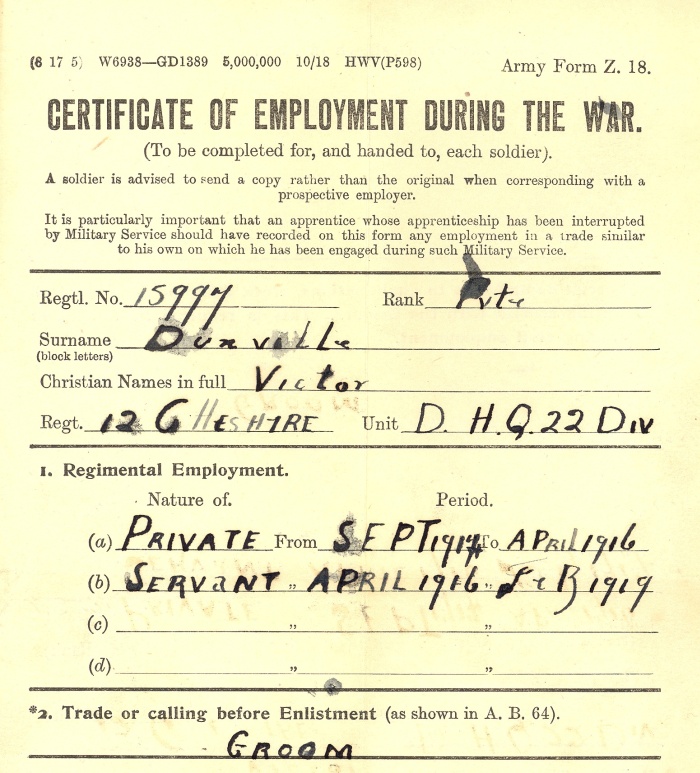 |
|
Above: Victor Dunville’s War
Record. Below, Vic in later life. |
|
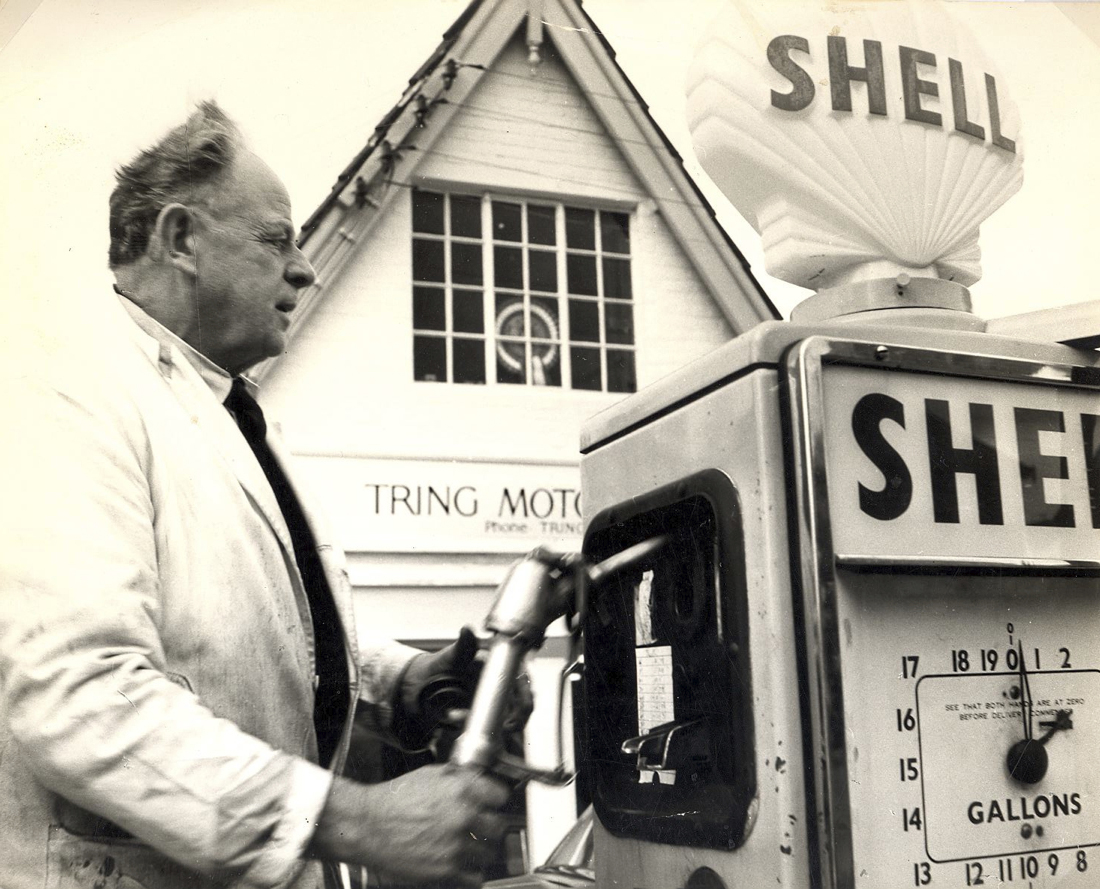 |
The exact sequence of events is difficult to work out, but it
appears that the Reverend Garnier had recovered sufficiently from
his illness to be retained abroad on active service for sometime
after the war ended, whilst both of his batmen returned to England.
This was hurriedly scribbled in pencil:
1 February 1919
Dear Dunville,
Mr. Rosby promised to send off my saddle and bridle long ago, do
please get it sent off at once and let me know. I also gave
him 50 drachmas for Broadbent and asked him to thank him for all he
had done – I hope he did not forget that too. Thank God I am
better and if the weather only mends I shall be getting to England
soon.
I look forward so much to seeing you again but can’t write more now.
Yours sincerely,
T. V. Garnier
This extract was written prior to a holiday:
24 June 1919
My dear Vic,
. . . . next door to where we shall be is a small motor man, and
during the day I want you to put in some time there as the man has
promised to teach you all he can, for I am very anxious that you
should have a trade in your fingers to which you can turn should
anything ever happened to me . . . . “
Having moved into Tring Vicarage, Garnier wrote to Dunville:
The Vicarage, Tring
29 October 1919
My dear Vic,
I enclose cheque for £5 due tomorrow. I want you to come to
Tring on Thursday, and I hope by that time to have your bedroom
ready as the first lot of furniture etc. comes in Tuesday and the
second lot on Wed. and some more will come in at the end of the
week. Booth is meeting me at Tring today and we are both going
into lodgings for the first few days so as to be near at hand and
get everything ready, and I expect we shall have a very strenuous
time but I thought it best for you to come on Thursday as I think
your lodgings fall due on that day. If you could take some
sandwiches and lunch in the train it would save time . . . .
Yours sincerely,
T. V. Garnier
Good as his word, Garnier did pay for Victor to learn to drive and
to obtain his license, which stood him in good stead for the future.
He remained in the vicar’s service until Garnier’s marriage in 1930
when he wrote the reference below; in the event, Victor obtained a
job at Tring Motor Company in Western Road, where he remained until
his retirement:
V. J. Dunville has been with me since
Easter Day 1916 when he became my batman on active service. He
is only leaving me because I cannot afford to give him the wages to
which he has been used. I can thoroughly recommend him as
trustworthy, sober and efficient. He understands valeting,
waiting, silver, housework and the care and driving of a motor car.
――――♦――――
Sons of past Tring clergymen also served in the war. LIEUT. COLONEL
EDMUND TIDSWELL,
D.S.O., [16] Leicestershire Regiment, the son of
Reverend Samuel Tidswell (Vicar of Tring 1892-1903), was a career
soldier who had seen service in India. Wounded in France early
in October 1914, he was awarded the D.S.O. for “services in
connections with operations in the field”. He was later
promoted to Brigade Major of the 81st Infantry Brigade, Egyptian
Expeditionary Force, and transferred to Salonika. Twice
Mentioned in Despatches, he retired in 1921, was awarded an O.B.E.
and recalled as a Recruiting Officer in WWII.
CAPTAIN HAROLD POPE,
M.C. and Bar, [17] 1st/2nd Lancashire, Royal
Garrison Artillery, was the son of Reverend Arthur Pope (Vicar of
Tring 1872-1881) and a mining engineer by profession. He was
working in Sumatra and Java when news of the hostilities reached him
and he at once resigned, returned home, and joined the Officer
Training Corps as a trooper. During the war he served
continuously in France being involved in most of the large
operations that took place on the Western Front. The citation
for the award of his M.C. in August 1917 reads:
He showed the greatest personal courage and presence of mind
in climbing on the top of a blazing gun pit and extinguishing a fire
which was threatening to blow up the whole of the ammunition at any
moment. There were thirty rounds of high explosive shells in
the blazing pit . . . .
The following year Harold Pope won a Bar to his M.C. in action near
Cambrai. Aged 36 and by then a very experienced officer, he
was killed on 24th October 1918 three weeks before the Armistice.
He lies in Heath Cemetery, Harbonnieres, Picardie, France, and his
name is inscribed on Tring War Memorial. [18]
|
An army chaplain’s life
was not always spent performing pastoral duties away
from the front line. This fact is nowhere more
evident than in the service record of the Rev. Theodore
Bayley Hardy V.C., D.S.O., M.C., who on many occasions
ministered to and rescued wounded men while under heavy
fire. His award of the Victoria Cross was “for
most conspicuous bravery and devotion to duty on many
occasions”.
The Rev. Hardy was wounded in action while tending to
casualties, and died a week later (18 October 1918) in
Rouen, two days before his 55th birthday. |
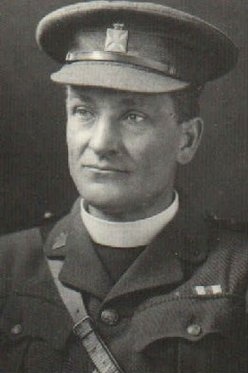 |
|
What for all time will the
harvest be, Sister?
What will spring up from the seed we have sown?
Freedom and peace and goodwill among Nations,
Love that will bind us with love all our own.
Bright is the path that is opening before us,
Upward and onward it mounts through the night:
Sword shall not sever the bonds that unite us
Leading the world to the fullness of light.
Major Frederick George Scott,
Chaplain to 1st Canadian Division.
From: A Treasury of War Poetry,
1917. |
――――♦―――― |
|
LETTERS FROM
THE
ROYAL FLYING
CORPS
AND
THE ROYAL
NAVY
One known letter survives from AIR MECHANIC
HORACE HEDLEY REGINALD
ROLFE (always known as Reg) to his aunt
in Charles Street, Tring, written six months before his death.
He was the eldest son in the large family of Frederick and Agnes
Rolfe who lived in Western Road, from where Frederick ran a very
successful coal, removal and charabanc business. Reg had
worked with his father and eventually was expected to take over the
firm, but fate decreed otherwise.
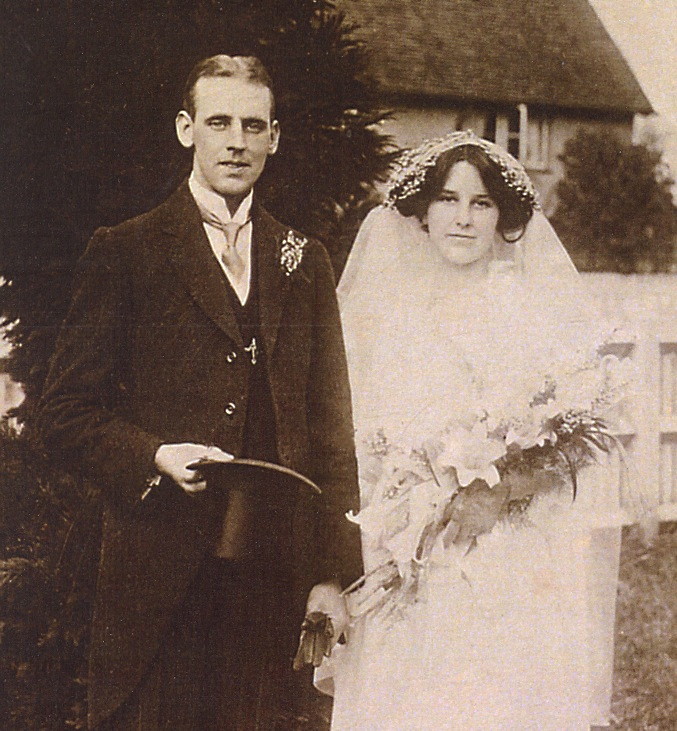 |
|
Reginald Rolfe and Doris
Plater on their wedding day at
Aston Clinton, 28 October 1914. |
Fascinated since seeing an early aircraft exhibition during the
manoeuvres at Halton Camp in 1913, Reg was quick to enlist in the
infant Royal Flying Corps. After the usual rather perfunctory
training of the time he joined his squadron to act as an observer in
flights over enemy lines, but his plane was shot down on his first
flight and he died from his injuries shortly afterwards. As
well as his grieving family, he left a young wife whom he had
married 18 months previously.
In the Field,
March 22nd, 1916
Dear Aunt Harriet,
At last I have found time to write you that long promised letter.
|
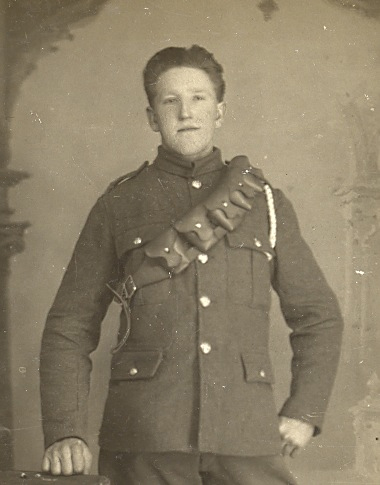 |
|
Driver Ralph Battson, Royal
Field Artillery. |
First of all I must thank you for the parcel which came to hand
safely, and which I much appreciated. It is very nice to know
I am not forgotten. From past experience I know that my aunts
will not do this. Tell May [his cousin]
I thank her very much for her contribution, I enjoyed both the
sweets and cigs.
I received a birthday card from Aunt Mag, but as I don’t know her
address I can’t write to her. Will you thank her for me and
give her my love.
Thanks also for your letter which I received some days ago. It
was very strange that I should see Ralph he was
going one way and I was going the other with my lorry. I
spotted him however and shouted and he recognised me. I was
sorry I could not have a chat with him.
|
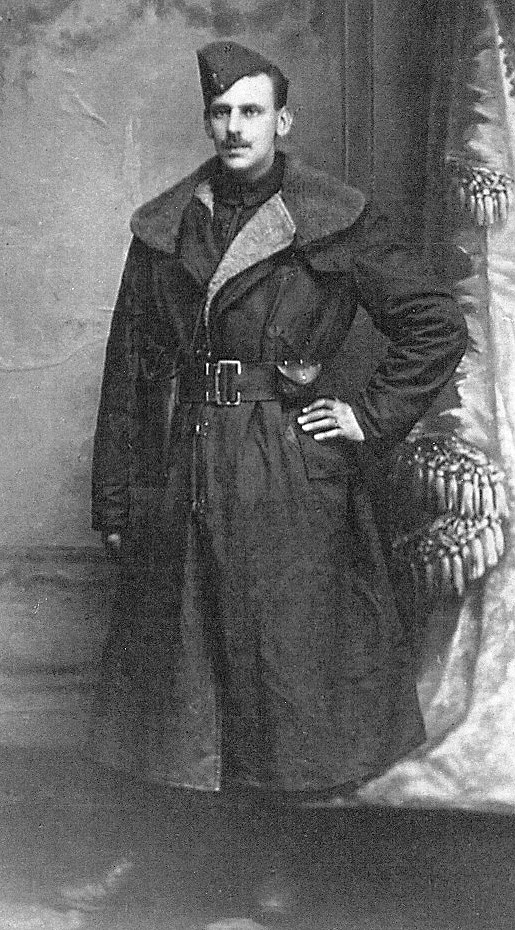 |
|
Air Mechanic Reginald Rolfe,
Royal Flying Corps. |
The ‘Ralph’ that Reg refers to was his cousin, Ralph Bertram Battson,
from Langdon Street. He was also in France serving in the
Royal Field Artillery. Ralph was killed by an enemy shell
behind the lines in 1917. Reg’s letter continues with news about
his wife and other family members before returning to the War:
I expect you would like to know what I
am doing out here. Well, as you know, I can’t say very much.
I am 1st man on a Leyland lorry and they are fine lorries. It
is quite a pleasant change after the lorries at home
[coal and removal lorries in his father’s firm].
The weather here has been rather rough, what with snow etc. but it
is much better now and you can guess we are pleased. I am
billeted in a fair sized town which of course must be nameless and
am pretty comfortable.
I have seen several fellows since I have been here – you remember
Len Griggs who worked for us. Shall be pleased to get a few
lines when you get an opportunity,
Yours sincerely,
Reg
Reg’s young widow, Doris, received the usual letter of condolence
from his commanding officer:
1 October 1916
. . . . I am sorry to say he was not
with us for long. He came on probation as an observer on the
20th of last month. On the 25th he went out with Lieut. Haward
over the lines. They were unfortunately hit by anti-aircraft
fire, all the controls being cut. The machine fell in our
lines and some sappers immediately went to the assistance of your
husband and Lieut. Haward. I am sorry to say that your husband
sustained injuries in the crash, from which he did not recover . . .
.
Yours sincerely,
P. C. Maltby,
Royal Flying Corps, B.E.F.
Reginald Rolfe lies in Barlin Communal Cemetery, Barlin, France.
So far as I can ascertain his pilot, 2nd Lieut. Reginald Stanley
Haward RFC was wounded in the incident, but appears to have survived
(and survived the war).
――――♦――――
A letter published in Tring Parish Magazine from an (unnamed)
OFFICER IN THE ROYAL
FLYING CORPS
serving in Italy:
April 1918
The other day when I was at . . . .
Aerodrome it began to snow so I beetled back here as rapidly as
might be. The snowstorm put up a pretty good fight but we beat
it alright. But we had to go! Normally I fly at 50-55
mph to ease the engine, but I saw that now that we should get a move
on. So I started at 70 mph and for the first 10 miles kept
level with the storm, which was about a mile away. I could see
quite clearly up to the storm, but then it looked like a thick white
mist. I said to myself ‘My child, carry on at 80 mph.
But even at this pace the snowstorm gained on us slightly.’
In the end we beat it by four fields; I have been caught too many
times by rain and snow to take any chances of going slowly.
These jiggers will do 105 mph near the ground and I was flying at
only 800 feet. It was quite amusing and my engine was
priceless.
I went up for a joy-ride the other day to try the electric heating,
which I think I told you about. There is a 250-volt dynamo on
the machine driven by a small propeller 18” across, and switch box
containing about eight switches. Three of these are for body,
hands and feet to keep you warm. For your body you put on
under your tunic a wash-leather waistcoat, which has resistance
wires all over it. For your hands you have thin cotton gloves
with wires down the back of each finger. For your feet you
have socks – the sort you put in your boots when they are too big –
these also have resistance wires in them.
The other switches are (1) for heating the machine guns to keep them
from freezing (2) to power the klaxon born used for contact when
flying (3) for navigation lights which are on the wing tips, and
also behind the observer and underneath the machine (these are to
show who and where you are in night flying), and also to prevent
being run into (4) for charging accumulators for wireless and (5)
for Holt landing flares, which are magnesium flares under each wing
for night landing and are fired by a hot wire. When I got up,
I turned on the three body switches and everything worked
gorgeously! In fact I had to turn the hands switch off after a
bit as they got too hot.
――――♦――――
From The Bucks Herald, 9 October 1914:
Mr. and Mrs. William Wells [of Tringford]
have received the following message from the King whose attention
was drawn to the fact of their six sons having volunteered for
service in His Majesty’s Forces.
Buckingham Palace,
17 September 1914.
I am commanded by the King to convey to you an expression of His
Majesty’s appreciation of the patriotic spirit which has prompted
your six sons to give their services to the Army and Navy.
The King was much gratified to hear of the manner in which they have
so readily responded to the call of their Sovereign and country, and
I am to express to you and to them His Majesty’s congratulations on
having contributed in so full a measure to the great cause for which
all the people of the British Empire are so bravely fighting.
I have the honour to be,
Your obedient servant,
F M Ponsonby
Keeper of the Privy Purse
Less than a week after Mr. and Mrs. Wells received the above
communication the cruisers Aboukir, Hogue and Crecy were torpedoed
and sunk by the German submarine U9 while they were on patrol in the
North Sea. [19] On board the Aboukir was one of their sons, STOKER
ARTHUR WELLS,
R.N.R. The Tring Parish Magazine published the
following in the November 1914 edition:
The first name of anyone from Tring who
has given his life for his country [20] and therefore will always find a
place upon our roll of honour, is that of Arthur Wells, Stoker, R.N.
Reserve. He was probably on duty below on that fatal 21
September when HMS Aboukir was torpedoed by the German submarine in
the North Sea.
We offer his wife, who will now return to her mother’s home in
Albert Street, and his parents (of Tringford) who have three other
sons on active service, and two more on merchant ships, our very
sincere sympathy.
――――♦―――― |
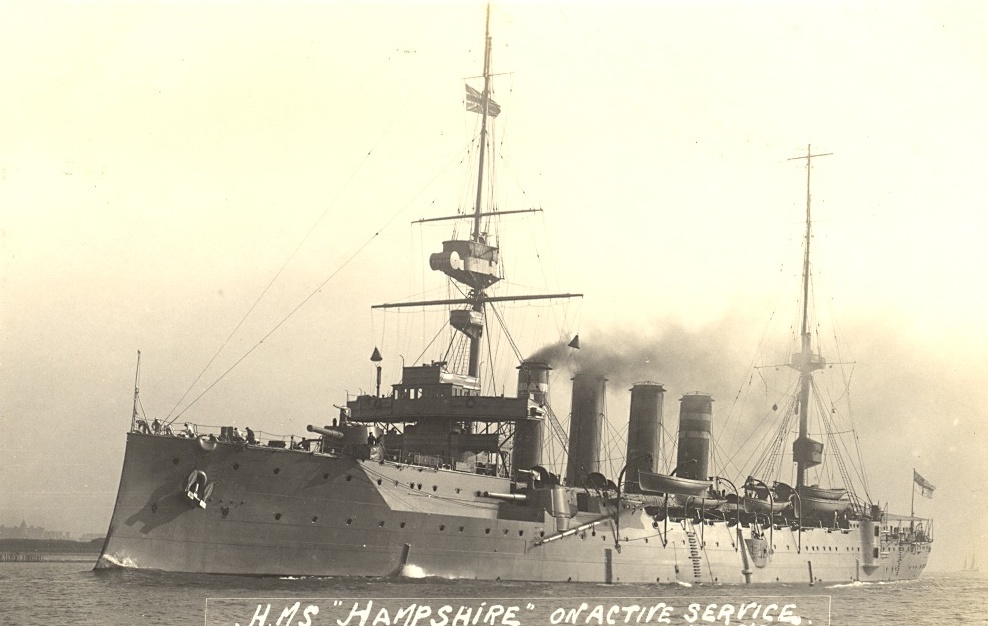
|
On the 5th June 1916, while on passage
to Russia, the Hampshire struck a mine
and sank with heavy loss of life,
including Kitchener and his staff.
From: ABLE SEAMAN STANLEY
COLLIER, R.N., written in June 1915 and
received by his parents, George and Annie Collier, of No.68 Brook
Street, Tring, two days after his death:
. . . . Just a few lines to let you know
that I am quite well. I hope you are all well at home and that you
have not been worrying about me at all. Our ship took part in the
naval battle the other day, and we sank one cruiser, but our ship
did not receive any damage at all, and no casualties. Do not worry
about things that you read in the papers, because a great deal is
not true . . . .
Stanley was right to be optimistic, for his naval career up to then
had included several lucky escapes. Born in Hastoe, a
woodsman’s assistant before joining the Navy in 1905, he had sailed
in 16 different ships, including the cruiser HMS Duke of Edinburgh,
which, in 1911, rescued the Duke and Duchess of Fife when they were
nearly drowned off the coast of Morocco. A little later, after
his minesweeper was wrecked off Lowestoft, he spent some time in the
water before being picked up.
He then transferred as stoker to the ill-fated cruiser HMS
Hampshire, which was to carry Lord Kitchener to Archangel (Russia)
on a secret military mission. The Hampshire left Scapa Flow
with an escort of two destroyers, but just over two hours later she
struck a mine, [21] sinking in 15 minutes and
taking with her most of the 749 on board, including Kitchener and his staff.
High seas contributed to the disaster, and of the 100 who managed to
reach shore only 12 survived the terrible surf of the landing.
Tring heard the news of the sinking with shock and sympathy, both
the local lad and Lord Kitchener were mourned, and muffled peals
were rung from the tower of the church. The body of Stanley
Collier lies in a double grave in Lynoss military cemetery on the
beautiful Island of Hoy on Orkney, but that of Kitchener was never
recovered.
It is a curious sidelight that on the very day that the Great War
started, Kitchener was staying near Tring at Ashridge House, when he
was summoned abruptly to the War Office. Supposedly, he said “Lady
Brownlow, I am sorry but I must leave at once. Do not worry,
you will know why tomorrow.” Later in the war, he again
visited Tring to inspect various contingents of the 21st Division
then billeted in the town. |
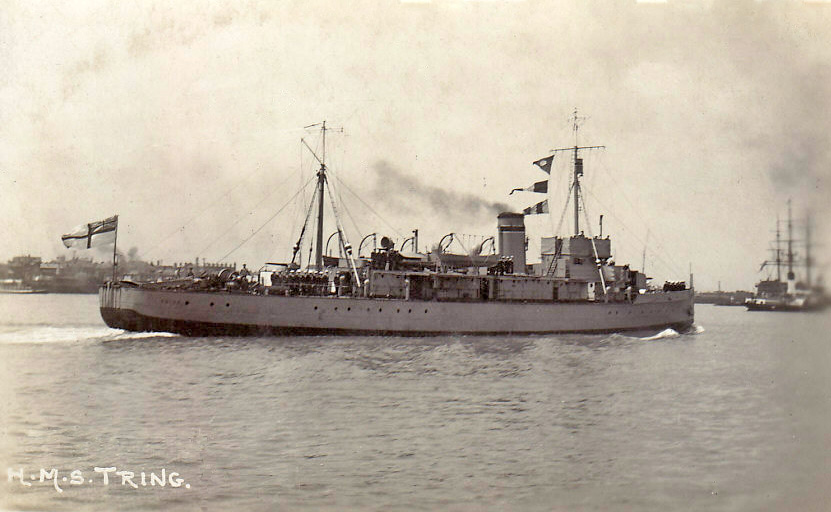
|
H.M.S. Tring was a Hunt Class
minesweeper completed for the Royal Navy in 1918/9. Too
late to see active service in World War I, in 1921 she became
tender to the Royal Navy training establishment H.M.S. Ganges.
During her time as such some 7,000 boys sailed in her to receive
their first experience of Man-o-War routine. In 1925 she
was placed in reserve as an economy measure and was sold for
scrap in 1927, being broken up on the Clyde where she had been
built. |
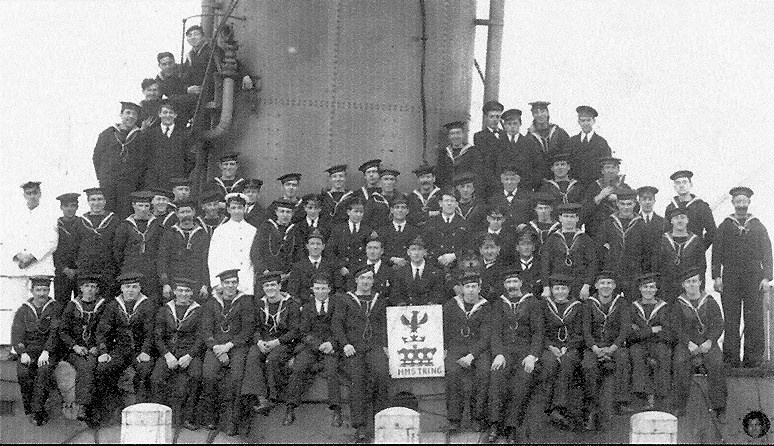
|
Not yours to know delight
In the keen, hard-fought fight,
The shock of battle and the battle’s thunder;
But suddenly to feel
Deep, deep beneath the keel,
The vital blow that rives the ship asunder.
Lieut. Noel F M Corbett, R.N.
To a Naval Cadet
Lost in H.M.S. Hogue, North Sea, August 1914 |
――――♦―――― |
|
THE GERMAN
CONNECTION IN
TRING
|
This is no case of petty
right or wrong
That politicians or philosophers
Can judge. I hate not Germans, or grow hot
With love of Englishmen, to please the newspapers
2nd Lieut. Edward Thomas [22] |
Every death of a young man in the Great War was its own tragedy, but
that of CHARLES HARTERT
more than most. The only child of Ernst and Claudia Hartert,
his German parents had come to Tring when Ernst, a specialist in
bird life, was appointed Director of Walter Rothschild’s Zoological
Museum in Akeman Street, and they became naturalised British
citizens shortly afterwards. Educated at Berkhamsted School
and Wadham College, Oxford, Charles enlisted as a Lieutenant in the
8th Battalion East Yorkshire Regiment, and soon embarked for France.
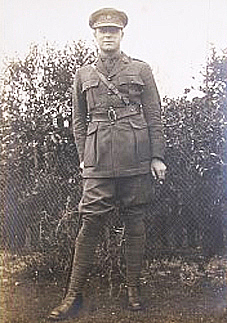 |
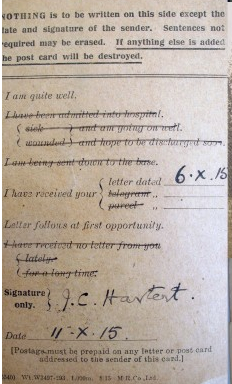 |
|
Left: Lieutenant (Joachim)
Charles Hartert.
Right: a correspondence acknowledgement form. |
During this time, due to the news of mounting casualties on the
Western Front and alleged reported German atrocities in Belgium,
jingoist feeling in the country ran high. German shops and
businesses were boycotted or looted, dachshunds supposedly were
kicked in the streets, even the King came under suspicion because of
his German ancestry. Tring was no exception to this sentiment,
and residents with German connections met with outright
unpleasantness or hostility including, unbelievably, Mr. and Mrs.
Hartert whose son was fighting in the British army.
Even after Charles was killed in action on the Somme (28th October
1916), the hostility continued — there was even opposition to his
name being included on the town’s war memorial. His
heart-broken mother never recovered from his loss and the
experiences she suffered at the hands of the townsfolk. When,
in 1930, her husband retired, she insisted they return to their
native Germany. However, the sad story continued after Ernst’s
death, for Claudia’s outspoken criticism of the Nazi regime led to
her being advised to leave Germany. She sought refuge in The
Netherlands, where she entered a convent in which she remained for
the rest of her life.
Charles Hartert lies in Courcelles-au-Bois Communal Cemetery,
France. His obituary in his old college magazine read:
J. C. Hartert came up from Berkhamsted
to Wadham in 1912, and played for the College both at Association
and at cricket. He was also a keen member of the O.T.C.
He was German by birth and combined the thoroughness and industry of
our enemies with the vigour and energy of his adopted country.
He took a commission immediately the war broke out, and had been at
the front for more than a year, having been slightly wounded last
July. He was a man of real character and considered one of the
best officers in his battalion.
By October 1916, Charles was one of only two remaining officers from
the battalion that had arrived in France twelve months earlier, the
other was his Captain, Paul Taylor. Both were killed by a
shell that landed in their dugout at Serre.
During the war Charles had corresponded with two of his childhood
friends in Tring, sisters and HILDA (HILDEGARDE)
and (GERTRUDE) ADA JORDAN,
as well as with their mother, Minna, whose husband, Karl, was a
colleague of Charles’s father at the Museum:
April 8th 1916
Dear Mrs. Jordan,
I have such a collection of letters and postcards from Hilda and Ada
that I don’t know which to write to this time, so I take the
pleasure (as our chaps say) of writing to you this time. As
you have probably heard, I am indulging in a week of two’s rest from
my labours, and am enjoying the best of health and so shall probably
return to the fray at an early date. The word above is not
PAY, I have spent all that! Joke, laugh!
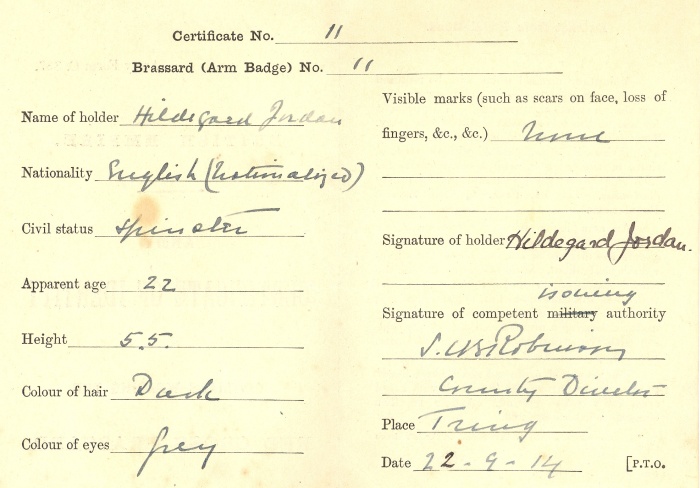
Hildegard Jordan’s V.A.D. Certificate of
Identity.
I really have nothing to say, have I
ever? There are French, British, Belgian and German soldiers
here – at present a Belgian band is entertaining us with strains of
beautiful music.
Well, au revoir!
Yours affect.,
Charles Hartert.
P.S. My love to all and please write
again soon.
21st I.B.D., France
4th May 1916.
Dear Hilda,
Many thanks for epistle of 22nd April. Am very fed up about
the way they have lost most of my last month’s correspondence
instead of forwarding it to me. Sorry you had the trouble to
write twice. As you see, I am at the base for a short time
before re-joining my regiment.
I met Dieppe Edelmann – now Major! Yesterday Chilton’s elder
brother paid a visit, he is a private in Australians – a very nice
chap. Please don’t send parcel before I get back to Rept.
Will let you know what and when later. It is very good of you
all to remember my feeding capacity; especially in regard to
peppermint creams!
Best wishes to Dr & Mrs Jordan, Ada and yourself,
Yours affect.,
Charles Hartert
|
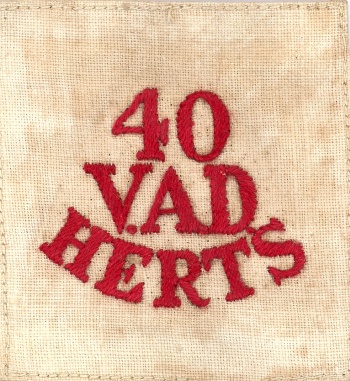 |
|
Ada Jordan’s V.A.D. armband. |
Hilda and Ada Jordan also experienced the virulent anti-German
feeling prevalent in WW1. Ada, aged just 17, when serving as a
V.A.D. [23] found that some of the soldiers in the hospital where she
worked refused to be nursed by her when they discovered that her
father was German by birth, even though a naturalised British
citizen.
Minna Jordan also wrote to other men at the Front, as well as old
friends, prisoners of war, and soldiers from the Northumberland
Fusiliers who had been billeted with the Jordan family in the early
days of the war. The following reply to one of her letters (in
pencil) was sent from a Field Post Office:
24th July 1917
4th Yorkshire Regiment, BEF
Dear Mrs. Jordan,
Just a few lines to let you know that I’m very well – in fact I’ve
never been better in my life and I more or less resemble a Red
Indian as the weather here is glorious.
I am sitting at the top of a deep dugout writing this, on a
delightful evening. It is pretty quiet just now for once in a
way . . . . I hope you are all well at present. I suppose
Tring is looking the same as ever? It doesn’t change very
much. It is a very long time since I last saw the place.
I should like to have got down there when I was home in January, but
I had such a frightful rush. 10 days goes very quickly.
Do you hear from any of those N.F. officers who were billeted with
you? I dare say there aren’t many of them out here now.
I spent two days in Paris some months ago, and greatly enjoyed it,
as it made a good change.
Well I must close now as it is time to go and have a look at the
war.
Kind regards to all.
Yours affectionately,
Douglas Spurway
――――♦――――
At one Council meeting during the war, Bentley Asquith, the U.D.C.’s
Engineer, had proposed that all Germans, including those of German
extraction, should be deported or interned. This action was
particularly spiteful to the Rothschild family of Tring, [24]
considering their patriotism and the generosity they had shown to
the town and to individuals in so many different ways. In the
absence of Walter Rothschild, a founder member of Tring U.D.C., and
the Council Chairman (and Tring Park agent), Richardson Carr, the
motion was carried and, unsurprisingly, led to the immediate
resignation of both. This hasty decision was immediately
regretted by some Council members and embarrassed reassurances were
soon uttered that there was no intention to direct the action at any
particular individuals; but the damage was done, and it was perhaps
as well that Lord Rothschild had died shortly before this unhappy
incident.
After the war, public demand led by an eminent Tring resident, Sir
Stephens Collins of Elm House, requesting that the town be allocated
a ‘war trophy’ to display in some prominent position. Not all
agreed that any form of triumphalism or reminder of the horrors of
war should be displayed and the proposal caused dissention amongst
Council members, some declaring themselves disgusted by the idea.
Again, the most fiercely in favour was BENTLEY
ASQUITH, who wrote the following letter to the
local paper: [25]
February 19th, 1919.
Sir,
I read with mixed feelings the decision of Tring Council to accept a
broken German machine gun and appurtenancies as a war trophy.
Surely we who have lost our gallant boys do not require these
hideous reminders of a bloody barbarism which brought such havoc to
civilisation the world over, and especially brought human suffering
to so many survivors and our homes. It can be no reverence or
compliment to our brave dead to have these monstrosities – as is
often the case – placed alongside the memorials we have reared in
their memory. Such relics are not worthy of notice as they do
not even possess the virtue of once belonging to an honourable foe,
and they should be smashed up as their former owners smashed up the
beautiful monuments and buildings of Belgium and Northern France.
Let us stamp out all this German taint from our midst if we are to
uphold the nation’s pride.
Yours very sincerely,
Bentley Asquith
In spite of the protests, the war trophy eventually arrived in the
shape of a very old German machine gun, which appeared never to have
been capable of firing. It was placed in the Fire Station, but
then soon removed to Miswell Lane Recreation Ground from where it
was quietly taken and sold for scrap.
――――♦―――― |
|
FOLLOWING
THE ARMISTICE
|
The tumult and the
shouting dies –
The captains and the kings depart . . . .
Rudyard Kipling |
The Armistice to end the Great War was declared and signed on
11th November 1918, when the fighting stopped, but it took six
months of negotiations at the Paris Peace Conference to conclude
the Peace Treaty, later signed at Versailles.
The carnage, that continued until the very last, was reflected
in Tring when PRIVATE SIDNEY
HAYSTAFF of Brook Street was
reported killed in action in Valenciennes on 5th November, and PRIVATE
ALBERT RANDALL
of Albert Street died of wounds in Rouen one day after the
Armistice. Both had been members of the Church Lads’
Brigade and had emigrated to Canada, only to return to fight for
the old country. |
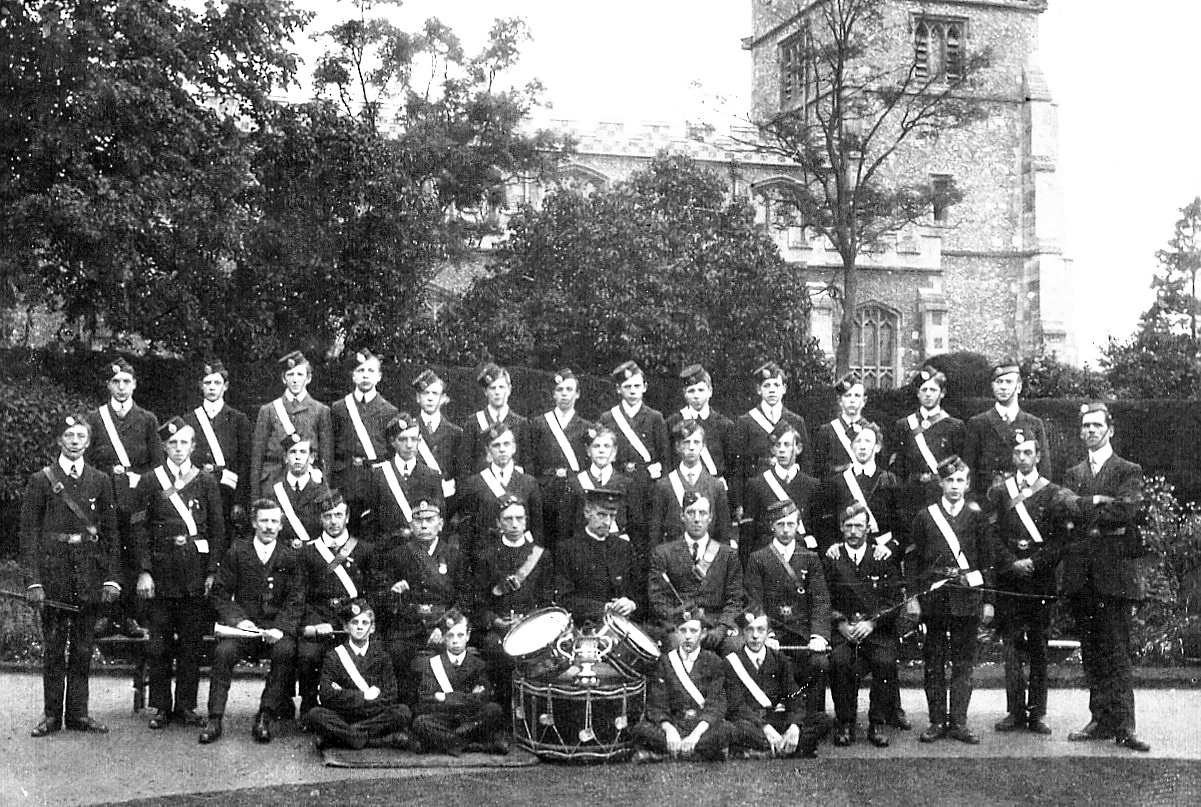
|
Tring Church Lads’ Brigade,
[26]
June 1912 —
Albert Randall is 3rd row, first on left.
Ralph Battson
is back row, third from left.
Mr. and Mrs. Arthur Ball of Longfield Road, must have experienced
extremes of emotion. They were first notified that their son, Arthur
Joseph Ball, was missing; then, on 30th October 1918, that he was
dead, only to receive a postcard from Arthur junior (from Brussels,
dated 2nd December) to say that he was well and hoped soon to be
among his friends.
The unveiling and dedication of Tring War Memorial had been planned
for 29th June 1918, but then The Bucks Herald published the
following account:
4th May 1918. Owing to the
requirement of the new Military Service Act on the staff of the
contractors for the erection of Tring War Memorial, the architect
has been informed that it will be impossible to complete the work by
St Peter’s Day and consequently the ceremony will be postponed until
the autumn. Up to the present time £400 has been subscribed,
the sum required being estimated at £450.
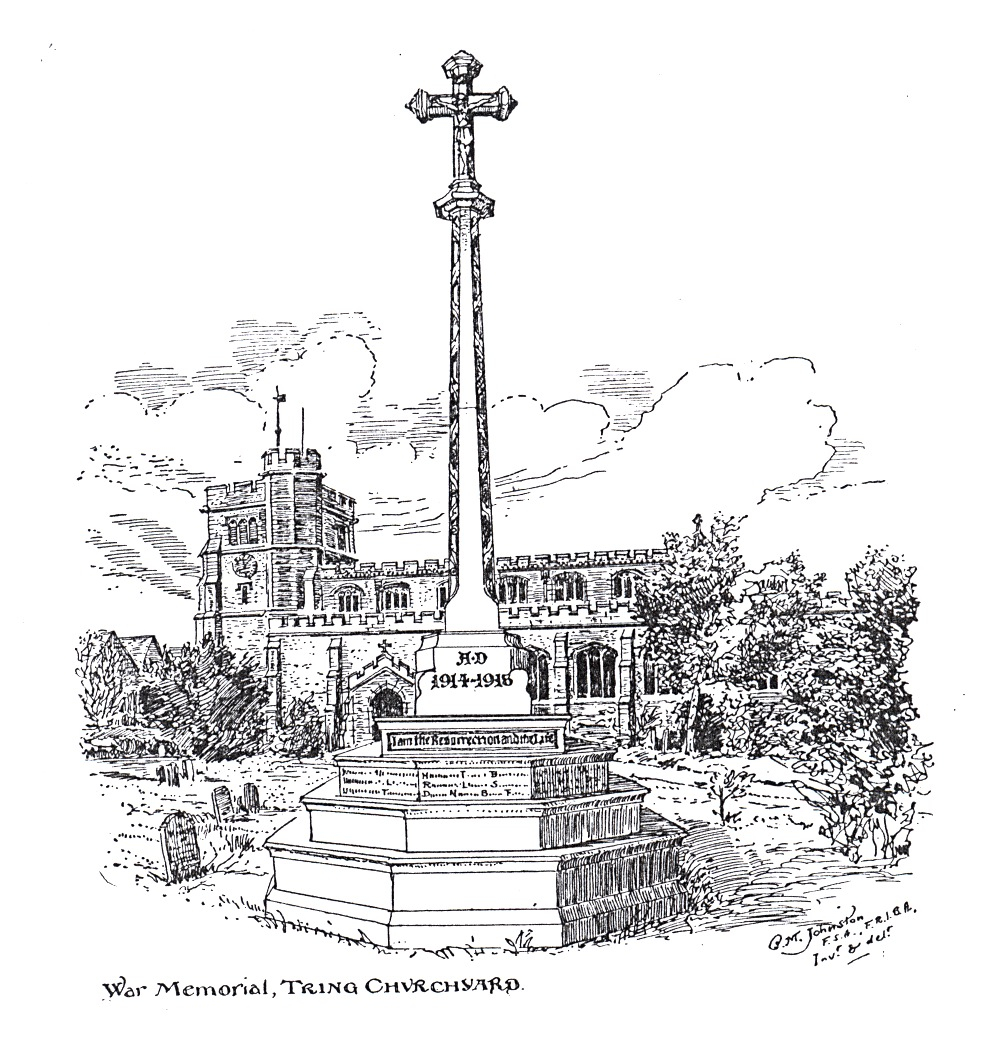
Architect Philip Johnston’s impression of his design.
Tring was generally admired for having the distinction of being the
first town in the country to erect such a memorial, and several
national newspapers commented approvingly. The Cardiff Evening
Express printed a picture of the memorial with the headline – “AS
IT SHOULD BE” the caption beneath stating “The
only War Memorial as yet properly completed and with the names
inscribed. Our picture shows the beautiful War Memorial at Tring,
Hertfordshire.”
The unveiling, performed by General Sir William Robertson, G.C.B.
K.C.V.O., D.S.O., (General Officer Commander-in-Chief, Great
Britain), took place on Wednesday, November 27th, 1918, on Church
Square. The General gave an address, followed by the dedication,
which was conducted by the Very Reverend T. C. Fry, D.D., Dean of
Lincoln, assisted by representatives of all religions. |
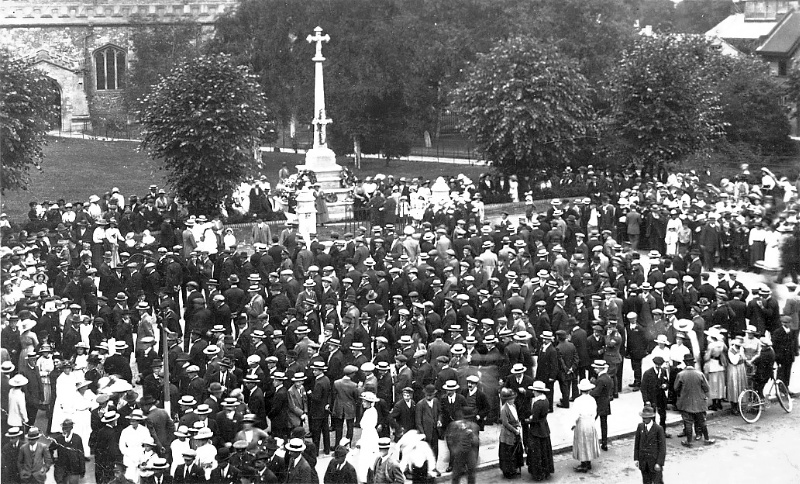
Thanksgiving
for Peace on Church Square: 24th July 1919 [Appendix].
|
The Peace Treaty was signed on 18th June 1919, exactly five
years after the assassination in Sarajevo of the Austrian
Archduke Franz Ferdinand and his wife had triggered the
conflict. Tring celebrated the National Day of
Thanksgiving for Peace on 244h July 1919, when 500 townsmen who
had served in the war lined up in the front of the war memorial
to pay their respects to fallen comrades. The numbers were
then swelled to over 2,000 for a short service that ended with a
sounding of the Last Post followed by a peal of the church
bells. Many then made their way to festivities held in
Tring Park to enjoy sports events, fancy dress parades, a grand
tea and, later that evening, a fireworks display.
The town gradually regained something approaching normality,
given that the influenza pandemic [27] and the coal and rail strikes
had first to be endured. In the various buildings in the
town that served as military hospitals, medical supplies were
packed up and sent back to Government stores. In 1919,
children returned to their pre-war schoolrooms, having spent
four and a half years in unsuitable and sometimes cold makeshift
conditions. The local paper reported that the town Council
considered that prices should come under examination, with the
result that seven members formed a ‘Profiteering Committee’; a
‘Food Control Committee’ was also set up that tried, without
success, to stop animals sold in the Tring cattle market from
leaving the town.
As funds permitted, pre-war leisure activities gradually
resumed. Cricket had been suspended for the duration of
hostilities, when the Tring Park C.C. Committee voted that all
members serving abroad should be made honorary members after the
war, although at the time no-one imagined this would be delayed
for four years. A new groundsman was not engaged until
1920, before which time sheep had been introduced to keep down
the grass in the outfield.
Collections were made in the cinema (The Empire, Akeman Street)
for the King’s Fund for the Disabled, and books for the wounded
were gathered and sent to the Library Branch of the British Red
Cross. A Victory Ball had been held at the Victoria Hall,
The Bucks Herald reporting that the hall was “profusely
decorated”; nearly 200 attended, most wearing fancy dress or
uniform, proceeds from the event being donated to the Local
Hospital Supply Depot.
The Council recommended the need for 50 new houses to be built,
and land owners were approached to assess their willingness to
sell; not all agreed. However, the owners of the Tring
Park Estate did offer the Dunsley Farm area to the County
Council for small-holdings for demobilised soldiers under Prime
Minister Lloyd George’s ‘Homes for Heroes’ scheme. [28] And the
Town Council agreed to tend the graves of the 14 soldiers who
died locally and are buried in Tring Cemetery.
Ex-servicemen returned to their pre-war occupations and pleasure
was expressed that some were setting up small businesses in the
town.
|
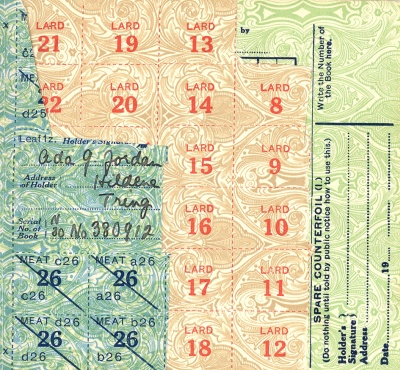 |
|
Meat and lard coupons from
a 1918 ration book. |
However, not all was success. Towards the end of the war
the Government had been forced to introduce the rationing of
certain foods as a consequence of the effective German U-boat
campaign. The Ministry of Food came under attack from the
town’s butchers who expressed dissatisfaction or even disgust at
the quality of imported meat reaching their shops. The
situation gradually eased, but butter remained rationed until
1920. In spite of coal rationing, introduced in 1916, late
in 1918 the Government announced that there would be a coal
shortage for domestic use during the approaching winter, and set
up machinery at local level to control its consumption.
During May 1919, 177 men were registered on the books of the
local Labour Bureau, a figure that was reported to be increasing
weekly.
Our small Hertfordshire town may have been picking up the
pieces, but in every city, town and village all over Europe, the
scars left by the bereavements and hardships of four years of
World War were not eclipsed even after a generation or more had
passed. Women struggling to bring up fatherless children,
men with missing limbs, blinded, suffering frightful facial
disfigurements, or damaged lungs (the result of mustard gas)
were constant reminders of the price that had been paid.
Tring was no exception to any of this; for many years afterwards
membership of The British Legion thrived, Remembrance Day
parades and services were well attended, and campaign medals and
decorations were worn with pride. All were mercifully
unaware that the oft-quoted saying that the Great War was “the
war to end all wars” was an illusion, and that the men of
Tring would be called upon again to march off to war just 20
years later. |
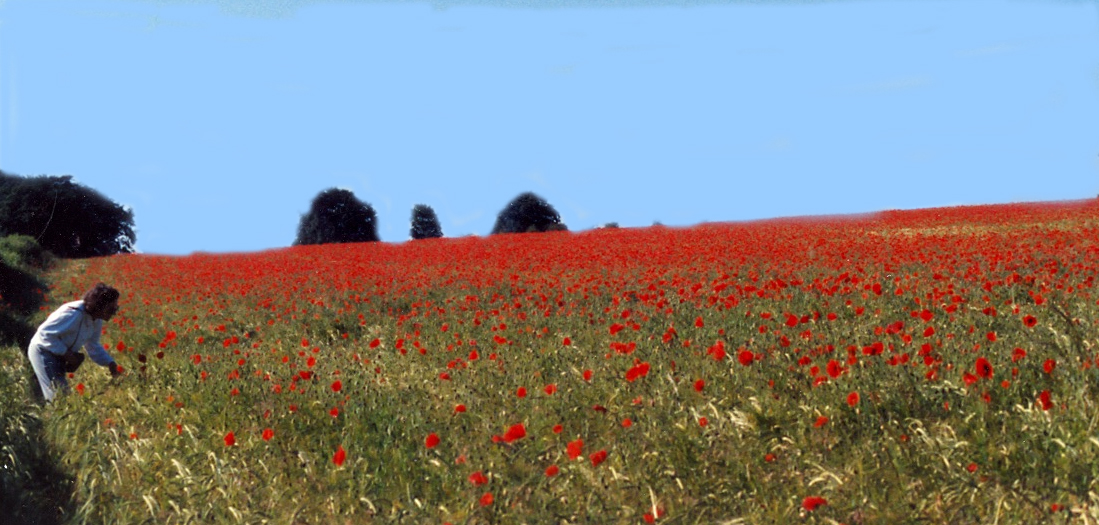
Poppies in Red Furlong, off Icknield Way, Tring.
|
Peace! Vex us not: we are the Dead,
We are the Dead for England slain.
(O England and the English Spring,
The English Spring, the Spring-tide rain:
Ah, God, dear God, in England now!) …
The snows of Death are on our brow.
Peace! Vex us not!
Brothers, I beg you be at rest,
Sing low your sleep in English ears:
And would ye have your sorrows wake
The Mother’s heart to further tears? …
Nay! Be at peace, her loyal dead.
Sleep! Vex her not!
Lieut. Walter Lightowler Wilkinson [29]
from: A Lament from the Dead |
――――♦――――
MEMENTOES
OF THE
GREAT
WAR
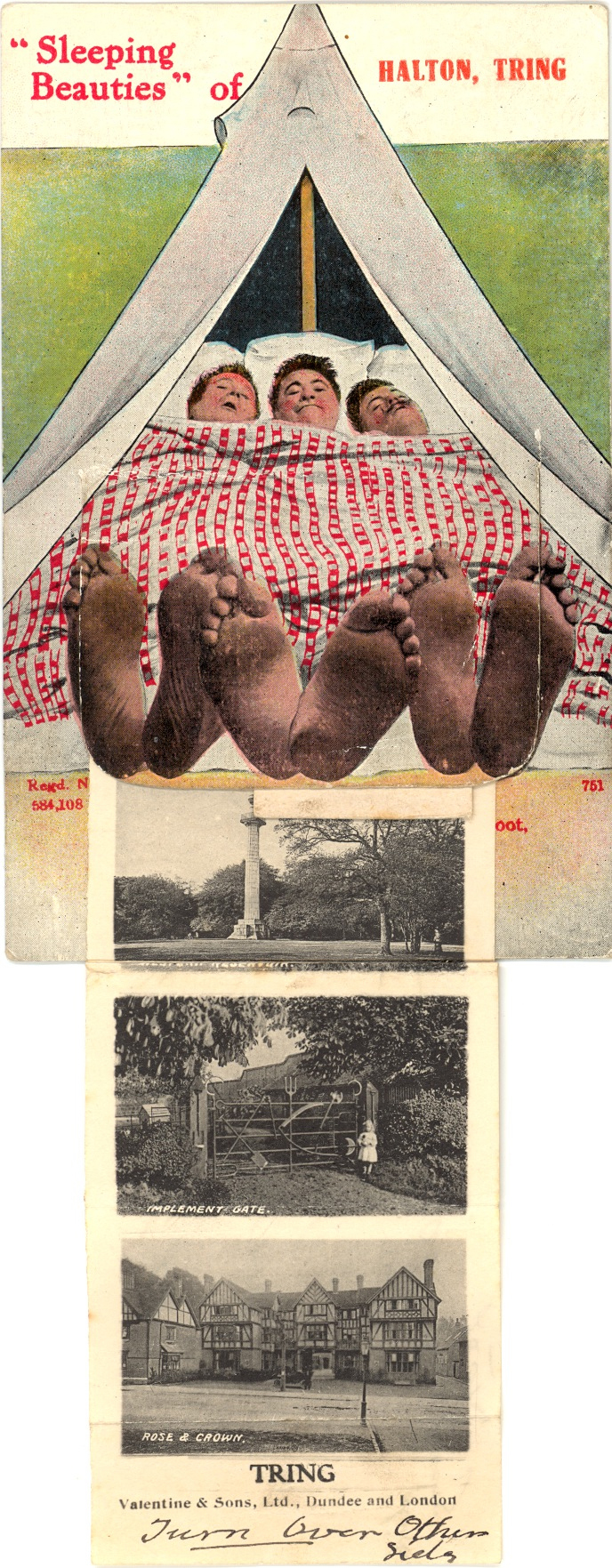
|
Humour in most situations – a pull-down view postcard sent from
Halton Camp by a soldier in the Northumberland Fusiliers to his
mother in Haltwhistle. |
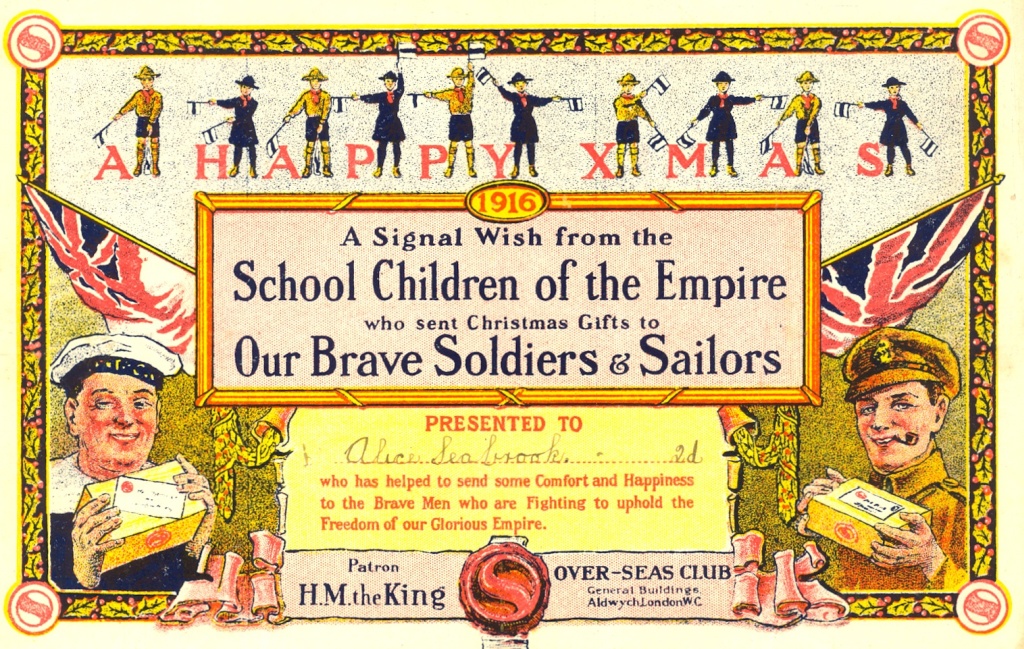
|
Above: a 1916 Christmas card
presented to Alice Seabrook of Western Road, Tring, who gave
2d.to the Christmas Gift for Soldiers & Sailors Fund.
Below: her older sister
and brother, Bet and Billy Seabrook, both serving in the Royal
Flying Corps; and the war grave of Billy in Terlincthun British
Cemetery, France; he was killed by a bomb on 25th September 1918
while on leave in Boulogne. |
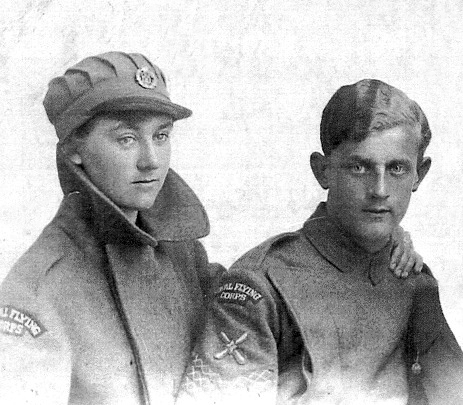 |
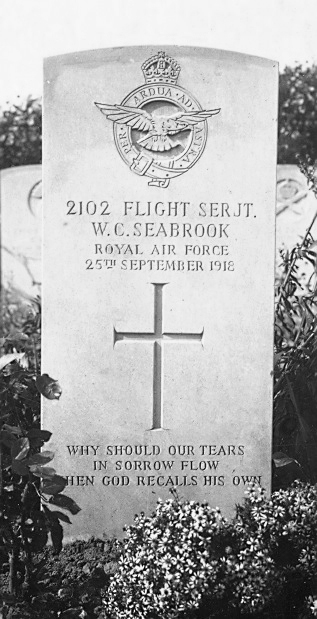 |
|
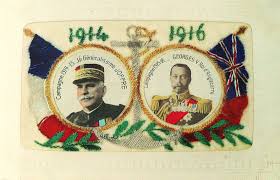 |
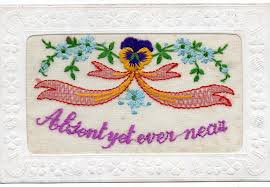 |
|
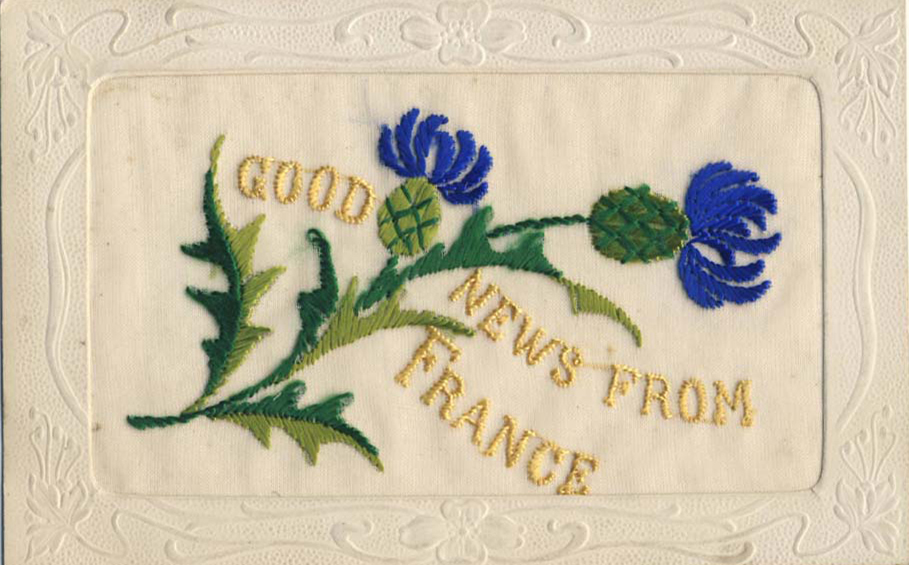 |
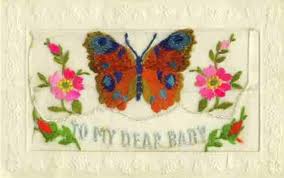 |
|
Above: examples of the many millions
of embroidered silk postcards sent home from France and Belgium
in The Great War.
Below: Ration Book from 1918, and
the Food Card which replaced it. |
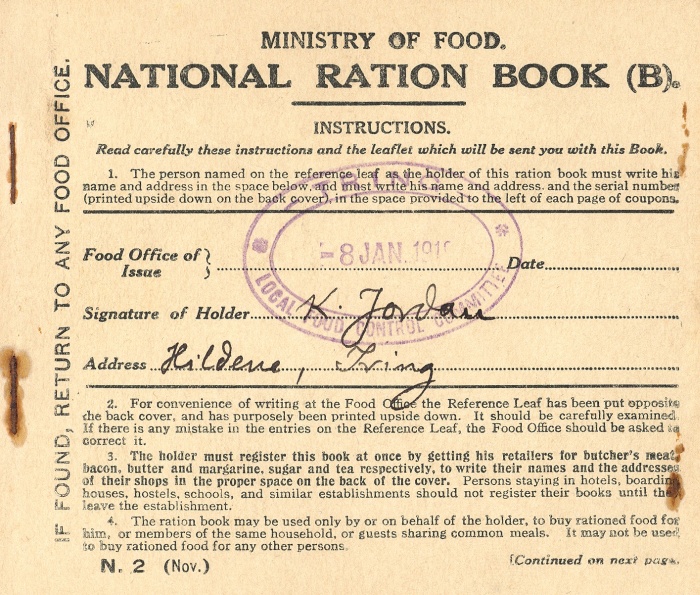 |
|
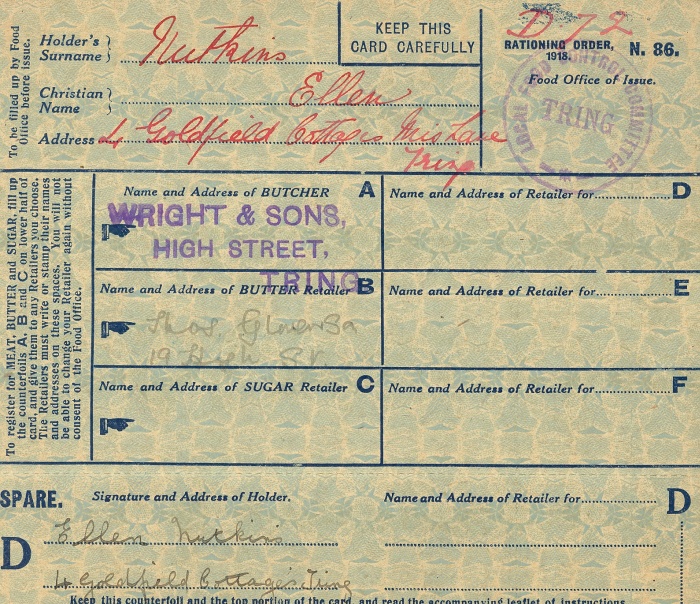 |
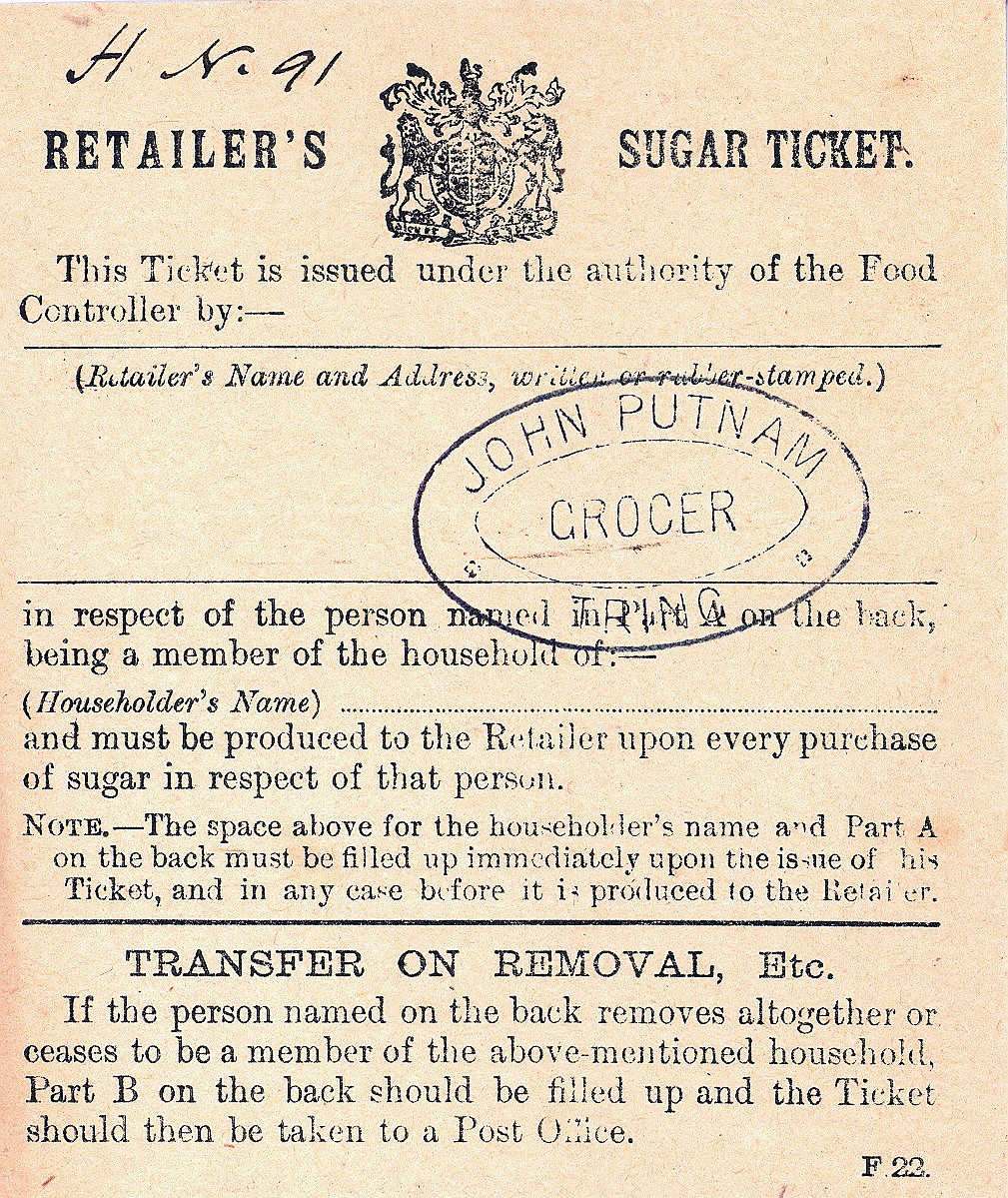 |
――――♦――――
TRING CRESTED
CHINA SOUVENIR
WARE
All circa 1914/1920
Bomb and Howitzer.
Tank and Armoured Car
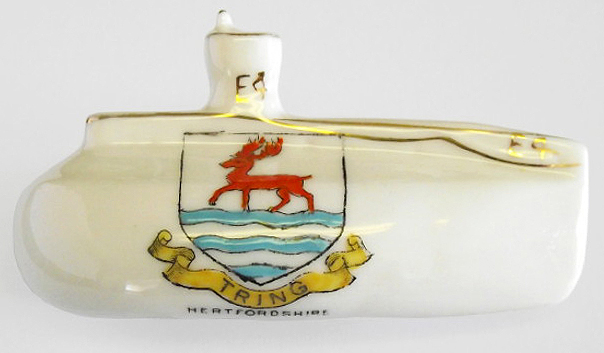
Submarine
――――♦――――
PIP, SQUEAK
AND WILFRED
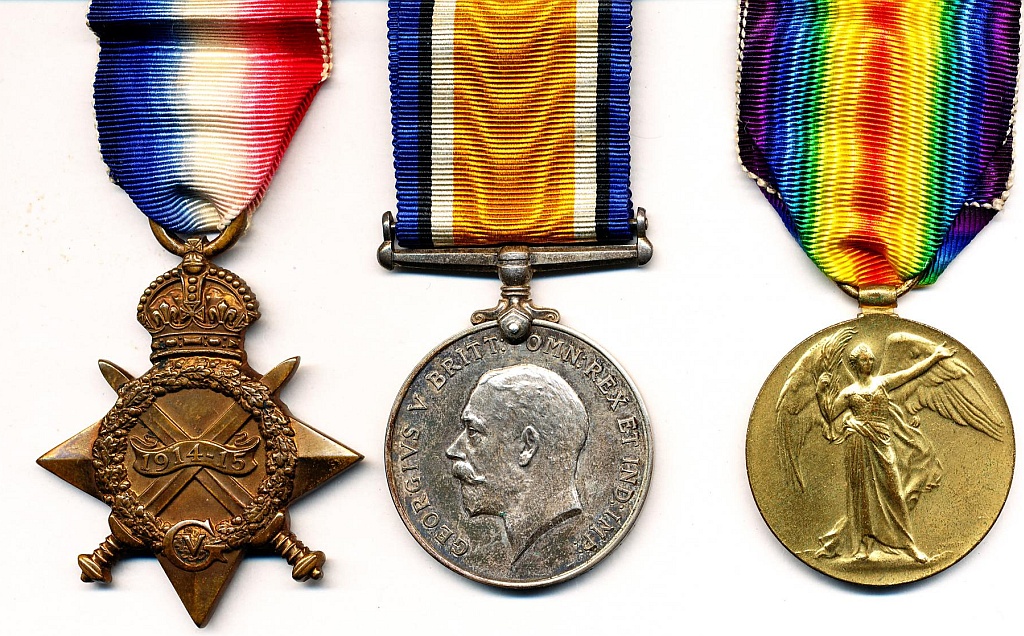
|
Pip, Squeak and Wilfred (named after
popular comic strip characters of the day) were awarded to men
who served in the Great War:
The 1914-15 Star (‘Pip’) awarded to those who saw service
between 5th August 1914 and 31st December 1915. No fewer that
2,350,00 were awarded, making it the most common British
campaign up to that time. A rarer variant of Pip is the
1914 or ‘Mons Star’, awarded mainly to the officers and men of
the ‘Old Contemptibles’ who landed in France soon after the
outbreak of war.
The British War Medal (‘Squeak’) was instituted to record the
successful conclusion of the Great War. Some 6,500,000 were
issued in silver and 110,000 in bronze (mainly to Chinese,
Indian and Maltese personnel in labour battalions).
The Victory Medal (‘Wilfred’) was issued to all who had received
the British War Medal. About 6,000,000 were produced. |
――――♦――――
|
FOOTNOTES
1. The German Chancellor described the Treaty as just a chiffon
de papier (a scrap of paper).
2. Contrary to optimistic cabinet opinion, Kitchener correctly
predicted a war that would last at least three years, require
huge new armies to defeat Germany, and suffer huge casualties before
peace was restored.
3. An Allied expedition to gain control of the Dardanelles and
Bosporus straits, capture Constantinople, and open a Black Sea
supply route to Russia. It was a major Allied defeat.
4. ― as it did in Germany due to the Royal Navy’s blockade of
its maritime imports.
5. The Great War was the first time that ‘Dig for Victory’ or
‘Victory Gardens’ were encouraged as a means of placing food on the
table, for many British merchant ships were being sunk leaving the
quantity of food imports severely diminished. The Dig for
Victory model reappeared in World War II.
6. The battle was one of the largest of World War I. Over 1,000,000
men were killed or wounded (650,000 British and French, 485,000
German), making it one of the bloodiest battles in human history.
7. During the Great War, more than two million U.S. soldiers served
on the battlefields of Western Europe of which some 50,000 lost
their lives.
8. Born 1895, killed at the Battle of Loos, 1915.
9. The Distinguished Conduct Medal
was an extremely high level award for bravery. It was replaced
in 1993 with the Conspicuous Gallantry Cross (CGC), which makes no
distinction between ranks.
10. The Middle Eastern theatre was the scene of action during most
of World War I. The combatants were, principally, on the one
hand the Ottoman Empire with some assistance from the other Central
Powers, and on the other hand the British (later assisted by Indian
troops) and, until their withdrawal from the conflict in December
1917, the Russians. During the later stages of the conflict T.
E. Lawrence (of Arabia) and his Arab fighters staged many
hit-and-run attacks on Ottoman supply lines.
11. Born 1897, Brooke died of sepsis en route to the Gallipoli
landings, 1915.
12. Probably the sole relic in Tring of WWI., this building was
removed in 2014 for use as part of a WWI. visitor display centre at
Hawstead, Suffolk.
13. This reference is to the red tabs that staff officers wore on
the lapels of their dress uniforms, which denoted them as
non-regimental officers who would never see actual fighting, but
work safely in the rear headquarters.
14. Guy Beech was born in 1886 in a Suffolk rectory. He served
as an Assistant Curate at Aylesbury, then Senior Curate of Tring,
and by 1916 was an Army Chaplain to the Forces (4th class) in the
Middlesex Regiment (formerly the Duke of Cambridge’s Own, nicknamed
‘The Diehards’) of the British Expeditionary Force.
15. The regiment was raised in Chester in 1914 as part of
Kitchener’s second new army. Before the war Thomas Garnier
served as domestic chaplain to the Bishop of St. Albans, and then
became vicar of St. Peter’s, Bushey.
16. The Distinguished Service Order (DSO) was a U.K. military
decoration awarded for meritorious or distinguished service by
officers of the armed forces during wartime, typically in actual
combat. It is sometimes regarded as an acknowledgement that
the officer had only just missed out on the award of the Victoria
Cross.
17. The Military Cross (MC) was a military decoration awarded to
officers of the British Armed Forces in recognition of “an act or
acts of exemplary gallantry during active operations against the
enemy on land”.
18. Two years before the war, Reverend and Mrs. Pope had experienced
a tragic loss when another son, an eminent mountaineer, was killed
in attempting a solitary rock climb in the Pyrennes.
19. The combined total from all three ships was 837 men rescued, and
62 officers and 1,397 enlisted men lost. Of these, Aboukir
lost a total of 527 men.
20. Ed. — this is incorrect. PRIVATE HARRY
POULTON, 2ND Battalion Highland Light
Infantry, B.E.F, was killed in action on 20th September 1914.
His name is on La Ferte-Sous-Jouarre Memorial on the south bank of
the River Marne, France.
21. One of several mines laid by the German mine-laying submarine
U-75 on 28/29 May 1916, just before the Battle of Jutland.
22. Born 1878, killed at the Battle of Arras, 1917.
23. The Voluntary Aid Detachment referred to a voluntary unit
providing field nursing services, mainly in hospitals, in the United
Kingdom and various other countries in the British Empire. The most
important periods of operation for these units were during World War
I and World War II.
24. The family originated in Frankfurt-am-Main and Lady Rothschild
was a native of that city.
25. To some extent ASQUITH’S
sentiments could be excused, for he had lost his 19 year
old son, 2nd LIEUT. GORDON
WILLIAM ASQUITH of the
King’s Own Yorks Light Infantry, who was killed in action on the
Passchendaele Ridge during the night of 2nd December 1917.
Because Gordon has no known grave he is commemorated on the Tyne Cot
Memorial.
26. The Church Lads’ Brigade was a movement founded in the late
Victorian period and seen by the Government as a potential source of
military cadets who could be called upon as required.
27. The influenza pandemic (‘Spanish flu’) lasted from January 1918
to December 1920 and is estimated to have killed between 3% and 5%
of the world's population.
28. A reminder of this scheme is the wooden bungalow (now Grade II.
listed) that is preserved at Dunsley Orchard.
29. Lieut. Wilkinson was an officer of the Inns of Court Regiment
who trained on Berkhamsted Common. He was killed in action at Vimy
Ridge in 1917. |
――――♦――――
APPENDIX
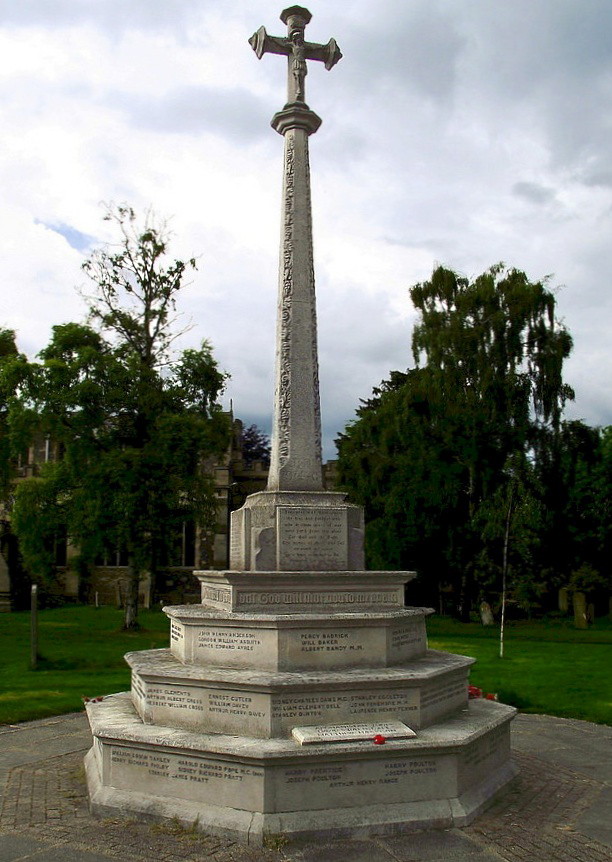
|
TRING’S
WAR MEMORIAL
Wendy Austin
On November 27th 1918, just sixteen days after the Armistice at the
end of the Great War, a significant event for the townsfolk of Tring
was enacted on Church Square, when the war memorial commemorating
those who had fallen was unveiled in a ceremony led by the Dean of
Lincoln.
It over a century since the outbreak of that conflict, and from this
distance in time it is difficult to appreciate the different
attitudes and sentiments that then prevailed. An account in the
Parish Magazine of the time relates that when war was declared, six
hundred men from Tring volunteered immediately or shortly
afterwards. Over eighty of these volunteers came from the ranks of
the local branch of The Church Lads’ Brigade. After the Military
Service Act came into force, three hundred more men were
conscripted, and the total then represented one-fifth of the
population of the town. Of the nine hundred men serving, Tring lost
one hundred and fourteen, a casualty rate more or less typical of
the country as a whole.
The town was more forceful than many others in its urgency to
remember with gratitude the young men who had given their lives in
what was believed and stated to be ‘the war to end all wars’.
(Having since lived through the rest of the twentieth century, this
description is now viewed with cynicism and near despair. In 1918 it
would have been beyond imagination that in less than thirty years,
more space on the Memorial would be needed for the names of those
killed in a second world conflict).
A plan for the erection of a war memorial in Tring was first
proposed in March 1917 by the town’s Chairman of the Church Council.
He stated that he had recently read an article by the great surgeon,
Stephen Paget, who suggested that the names of the dead in the Great
War be presented in well-shaped legible letters on veined or
lustrous marble, with sufficient spacing for each name to be shown
in full. Mr. Paget further explained his idea by saying: “Over all
these names there might be the figure of Christ on the cross − not
shut in churches, but set in the open air. Such a figure is
singularly close to the war, and the Dead. In all art, there is no
solitary figure so effective.”
Tring took these comments to heart and by August of that year the
Church Council was in a position to consider the submissions of
various architects. The unanimous selection was a drawing by Philip
M. Johnston FSA, FRIBA, who was asked to visit the site and submit a
more detailed plan together with an estimate of cost. The chosen
design of an old English cross carrying the figure of Christ, rose
to a height of twenty-three feet from an octagonal plinth. Donations
were requested, and the required total of £575. 5s. 10d. was soon
raised.
It was hoped that the unveiling could take place on St. Peter’s Day,
but the contractors were so overwhelmed with work on military
gravestones that the event had to be postponed until the autumn.
When building work was complete the memorial was swathed in a Union
flag until the unveiling and dedication ceremony. (As the war was
still not over, the cross was erected without the carving of the
names). Referring again to the Parish Magazine we learn that after a
week of drenching rain and high winds the unveiling day dawned fine
and sunny. A small platform was erected in front of the new memorial
for General Sir William Robertson, who performed the ceremony, the
Dean of Lincoln, the Vicar of Tring and the architect, Philip
Johnston. Leaders of other religious faiths were also represented.
The square must have been an impressive sight, for the guard of
honour and band was supplied by one hundred men of the Inns of Court
Officer Training Corps, whose recruits had trained on nearby
Berkhamsted Common. Tring turned out in force, for during the four
years of conflict most people in the town had lost a relative or
friend.
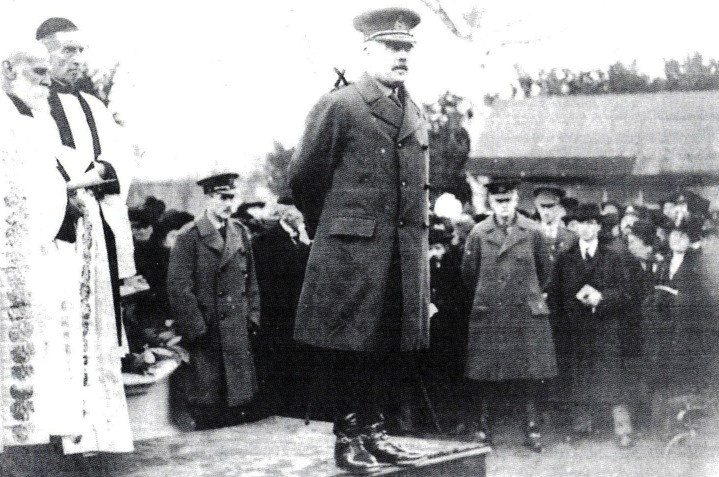
General Sir William Robertson at the
unveiling ceremony, 27th November 1918.
Later, when the names were inscribed on the memorial, the list
included seven men who had won decorations − one Victoria Cross; one
Distinguished Conduct Medals; three Military Crosses (one being with
bar); and three Military Medals. In 1914 many of the soldiers from
Tring had left for France with the Herts Territorial Battalion which
took part in several engagements, with the Guards Brigade in the
Second Division. These men fought at the second Battle of Ypres,
where the battalion lost all its officers, and all but one hundred
and thirty of its men. Later in that same year, the battalion saw
action on the Somme, again losing all its replacement officers as
well as five hundred men. Other Tring men in the Beds & Herts
Regiment also saw action on the Somme, the 7th Battalion advancing
at 7.30 am on the first day of the battle (1st July 1916). The
Regimental history relates that the objective of capturing the
first-line system of German trenches was achieved, but the price
paid had been the loss of all its officers.
Tring’s promptness in erecting its war memorial set an example for
many other towns and villages in the country. This was commended in
several newspapers including the Evening News in June 1919, and in
October of the same year the Cardiff Evening Express printed a
picture of the memorial with the headline: “AS IT SHOULD BE”, the
caption beneath stating: “The only War Memorial as yet properly
completed and with the names inscribed. Our picture shows the
beautiful War Memorial at Tring, Hertfordshire.”
Three months previously a special day had been declared as a
National Thanksgiving for Peace, and at the request of the returning
servicemen, a short informal service was held on Church Square to
honour those killed in the conflict. The relief at the end of all
the slaughter and deprivations, rightly or wrongly, triggered the
Council to suggest that a celebration should follow the service.
This took the form of a gathering in Tring Park with sports events,
a fancy dress parade, and tea served to over one thousand five
hundred people. In the evening there was a firework display and a
torchlight procession. However, the arrangements for the special day
had not been entirely trouble-free. Dispute had arisen between the
organisers over the tricky question of whether or not to provide
free beer. This caused committee members to split into two factions,
one staunch chapel-goer stating: “There is great danger in the
suggestion of free beer.” Another opposed this view and said: “After
the experiences of the men, and what they have gone through, it is
humbug to think they should not have a glass of beer.” In spite of
this commonsense approach, the proposal to give beer was defeated by
fifteen votes to twelve. Those unable to get to the park on that day
were not forgotten, for in the following week, an entertainment with
lavish tea was arranged for all those over sixty-five years,
including those described as ‘cripples and the afflicted’, and the
wives of men who fell in the war.
For many years Tring’s war memorial was half-hidden by the gates in
the churchyard wall, which were only opened on Remembrance Sundays.
At that time Church Square was a car park which grew increasingly
busy over the years, and the resulting bustle caused the memorial to
be over-shadowed. In the 1990s the decision was taken to refurbish
the square, which included removing the gates and opening up the
area generally. The monument now presents a striking aspect, as well
as an opportunity for quiet reflection − surely the purpose of those
concerned in its original planning and design. |
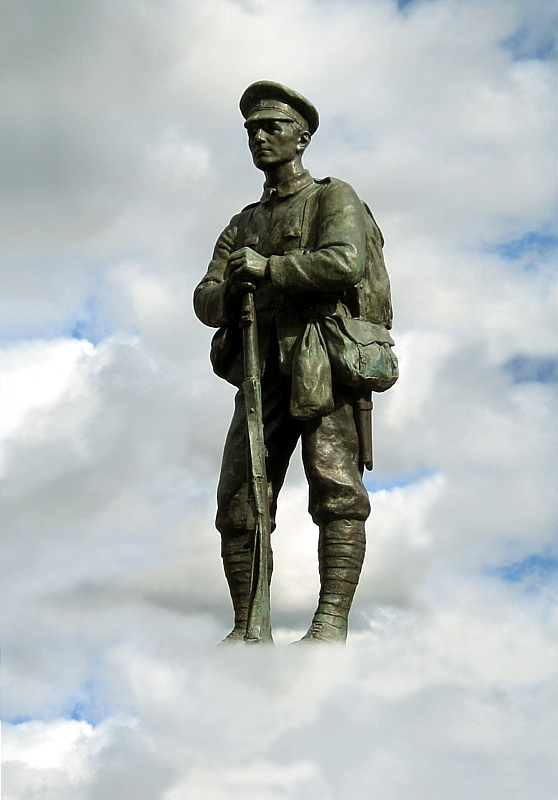
――――♦――――

<>
|



